- Coffeeshops
- Restaurants
- Erotic Venues
- Tips & News
- Facts & Statistics
- Fun Things To Do’s
- Hotels & Hostels
- Laws, Rules & Etiquette
- Map & Directions
- Must Know Info
- Prices & Costs
- Prostitution
- Amsterdam Buddhist Temple
- Amsterdam Salvation Army
- Amsterdam Stock Exchange
- History of Prostitution Netherlands
- Red Light District
- The Old Church

Amsterdam Currency: A Complete 2024 Guide
Posted on: January 2, 2024
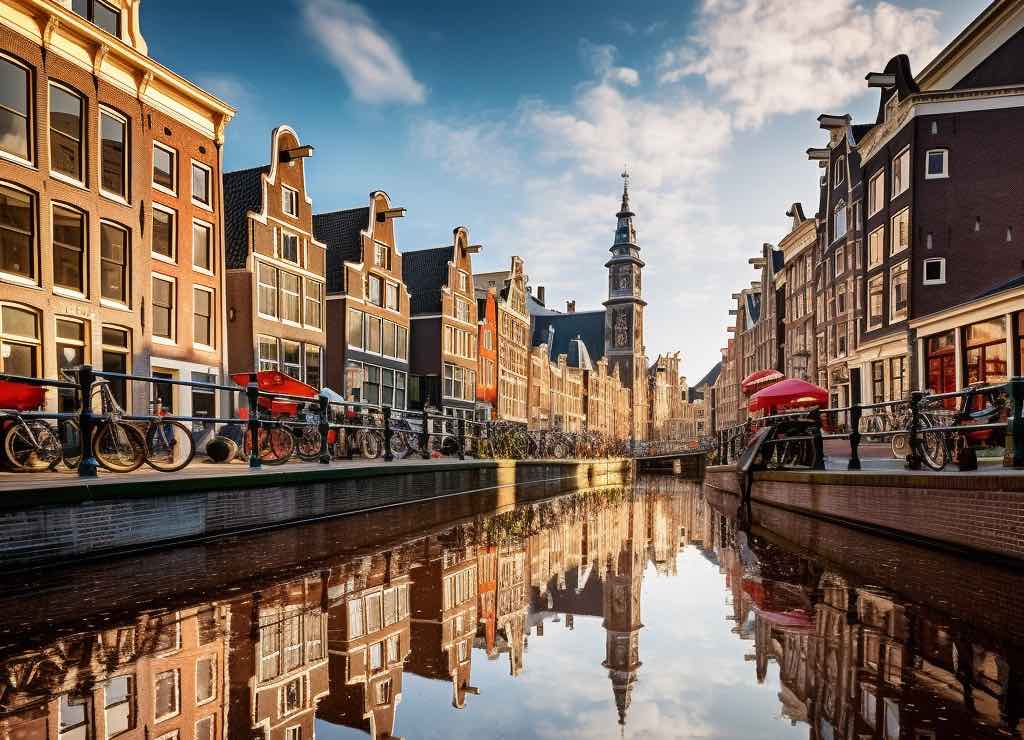
Amsterdam Currency 2024: Navigating the City’s Financial Landscape
Navigating Amsterdam currency in 2024 is key to unlocking the full potential of your visit to this enchanting city. As the vibrant heart of the Netherlands, Amsterdam not only boasts picturesque canals and rich cultural heritage but also a dynamic financial landscape. Whether it’s your first visit or you’re a returning admirer, understanding the nuances of Amsterdam’s currency system is crucial. This city, famous for its historic architecture and bustling markets, requires a savvy approach to financial transactions to fully enjoy everything from a leisurely coffee in a quaint café to the excitement of shopping for unique finds.
Table of Contents
Amsterdam’s status as a premier tourist destination makes it more important than ever to be well-informed about its currency. How you manage your finances here can greatly affect your travel experience, influencing everything from where you dine to what souvenirs you bring home.
In this blog post, we dive into the top 10 things you need to know about Amsterdam’s currency in 2024. From understanding the latest digital payment trends to mastering currency exchange, we’ve got you covered.
Picture yourself wandering through Amsterdam’s charming streets, confidently handling every financial interaction. With this guide, you’ll not only become proficient in using Euros but also adept at navigating the city’s shift towards digital payments, ensuring a smooth and memorable trip.
Continue reading to gain these essential insights. Prepare for an extraordinary journey in Amsterdam, where your knowledge of the local currency will enhance every aspect of your adventure.
10 Things You Need To Know About Amsterdam Currency
- Currency Type : Amsterdam uses the Euro (€) as its official currency.
- Banknote Denominations : Available in 5, 10, 20, 50, 100, 200, and 500 euros.
- Coin Denominations : Includes 1, 2, 5, 10, 20, 50 cents, and 1 and 2 euros.
- Cash vs Digital : Both cash and digital payments are widely accepted.
- ATM Availability : ATMs are abundant and compatible with international cards.
- Currency Exchange : Best rates at banks and major transport hubs.
- Tipping Culture : Tipping is customary but not obligatory, usually 5-10%.
- Security Features : Euro notes have advanced anti-counterfeiting measures.
- Card Acceptance : Credit and debit cards are widely accepted, but have some cash.
- Cultural Transition : Switch from Dutch Guilder to Euro in 2002 marked a significant cultural shift.
Current Currency Used in Amsterdam
Amsterdam, like much of the Netherlands, primarily uses the Euro (€) as its official currency. Introduced in 2002, the Euro has since become a significant part of European trade and economics. In 2024, tourists and residents in Amsterdam will encounter Euro banknotes and coins in various denominations. Banknotes come in 5, 10, 20, 50, 100, 200 and 500 Euro values, each with distinct colors and sizes for easy recognition. The coins are in denominations of 1, 2, 5, 10, 20, and 50 cents, and 1 and 2 Euro. Each coin and note is uniquely designed, featuring different European architectural styles across various periods, symbolizing the unity and diversity of Europe. Understanding the denominations and their physical characteristics can be crucial for visitors to manage their finances effectively while in Amsterdam.
Currency Exchange Tips
Navigating currency exchange in Amsterdam requires some know-how to ensure you’re getting the best deal. In 2024, numerous currency exchange offices can be found around major tourist areas and transport hubs like Schiphol Airport and Amsterdam Centraal Station. However, it’s essential to be aware of the exchange rates and commissions charged. Often, banks offer better rates compared to standalone exchange kiosks. Another tip is to avoid exchanging money at hotels due to typically unfavorable rates. It’s also wise to compare rates online and consider exchanging a portion of your money before traveling. Some travelers opt for pre-paid travel cards available from banks, which can offer competitive rates and reduce the need to carry large amounts of cash.
Cash vs. Digital Payments
The payment landscape in Amsterdam, as of 2024, reflects a blend of traditional and modern practices. While cash is still widely accepted, there is a noticeable shift towards digital payments. Contactless card payments and mobile payment apps have become increasingly prevalent in restaurants, shops, and even in markets. For travelers, it’s crucial to have a mix of payment options. While larger establishments readily accept digital payments, smaller shops or local markets might prefer cash. It’s always advisable to carry some cash for small purchases. Understanding the balance between cash and digital payments in Amsterdam can significantly enhance the convenience of transactions during your stay.
ATM and Banking Services
ATMs are widely available throughout Amsterdam, offering convenient access to cash for both locals and tourists. Most ATMs in the city support major international credit and debit cards, making withdrawals straightforward. However, it’s essential to be aware of potential fees for international transactions. These can vary depending on your bank’s policies and the ATM’s operating bank. In 2024, several international banks have branches in Amsterdam, providing full banking services to their customers. It’s advisable to inform your home bank of your travel plans to prevent any unexpected card blocks due to foreign transactions. Additionally, keeping an eye on the daily withdrawal limits and planning your banking needs accordingly can help avoid any inconveniences.
Cultural Tips Related to Money
Understanding the local money-related customs and etiquettes can enhance your experience in Amsterdam. Tipping, for instance, is customary but not mandatory in the Netherlands. In restaurants and cafes, it’s common to leave a small tip, typically around 5-10% of the bill, if the service is satisfactory. However, tipping in other services like taxis or hairdressers is less common and is usually a matter of personal choice. Bargaining is not a standard practice in Dutch stores or markets, so prices are generally considered fixed. However, at flea markets or when purchasing art or antiques, some negotiation might be acceptable. Being aware of these cultural nuances related to money can help avoid any social faux pas and ensure a smooth experience while shopping or dining in Amsterdam.
Frequently Asked Questions
What is the currency used in amsterdam in 2024.
In 2024, Amsterdam uses the Euro (€) as its official currency. It includes banknotes in denominations of 5, 10, 20, 50, 100, 200, and 500 euros, and coins in 1, 2, 5, 10, 20, and 50 cents, and 1 and 2 euros.
Where is the best place to exchange currency in Amsterdam?
The best places for currency exchange in Amsterdam are banks and specialized currency exchange offices in major tourist areas and transport hubs like Schiphol Airport and Amsterdam Centraal Station. Banks usually offer more favorable rates compared to standalone kiosks.
Are credit cards widely accepted in Amsterdam?
Yes, credit cards are widely accepted in Amsterdam as of 2024, especially in hotels, restaurants, and larger stores. However, it’s advisable to carry some cash for smaller shops and local markets.
Can I use digital payments in Amsterdam?
Digital payments, including contactless card payments and mobile payment apps, are increasingly popular in Amsterdam. They are accepted in many establishments, though cash remains a viable option for smaller transactions.
Are there any ATMs in Amsterdam where I can withdraw cash?
Amsterdam has a dense network of ATMs that support major international credit and debit cards, making it convenient to withdraw cash across the city. Be aware of potential fees for international transactions.
What are the tipping customs in Amsterdam?
Tipping in Amsterdam is customary but not mandatory. In restaurants and cafes, a tip of around 5-10% of the bill is common if the service is good. Tipping in other services like taxis is less common and is usually at the customer’s discretion.
Is the currency used in Amsterdam’s Red Light District different from the rest of the city?
No, the currency used in Amsterdam’s Red Light District is the same as the rest of the city, which is the Euro (€). Just like in other parts of Amsterdam, both cash and digital payments are accepted in the Red Light District, but it’s advisable to carry some cash as sex workers and smaller establishments might not accept cards.
In exploring the intricacies of Amsterdam’s currency, an intriguing aspect to consider is how it plays into the diverse facets of the city’s culture and economy, particularly in areas like the Red Light District. Understanding the dynamics of currency becomes even more relevant when you delve into specific sectors of Amsterdam’s vibrant urban landscape. For those interested in a deeper insight into how the Euro impacts various services and experiences, including those in the Red Light District, a comprehensive guide to the Red Light District cost offers a detailed perspective. This guide not only sheds light on the monetary aspects but also provides a broader understanding of the economic framework of one of Amsterdam’s most famous and historic areas.
Amsterdam Currency Facts
- Polymer Notes Introduction : While traditionally made from cotton paper, the Eurozone has been considering the introduction of polymer notes for future Euro banknotes. Polymer notes, already used by several countries, are more durable and resistant to wear and tear compared to paper notes.
- Smallest and Largest Denominations : The smallest denomination of the Euro currency is the 1 cent coin, while the largest is the 500 Euro banknote. However, the 500 Euro note is no longer being issued since January 27, 2019, due to concerns about its use in illicit activities, though it remains legal tender.
- Euro Symbol Origin : The Euro symbol (€) is inspired by the Greek letter epsilon (Ε), reflecting the cradle of European civilization, and the first letter of the word ‘Europe’. The two parallel lines signify the stability of the Euro.
- Exchange Rate Impact : The Euro’s value against other currencies, particularly the US Dollar, has a significant impact on Amsterdam’s tourism and trade. A stronger Euro can make Amsterdam more expensive for tourists, while a weaker Euro can boost tourism and exports.
- Legal Tender Status : Euro banknotes and coins are legal tender across the Eurozone. This means they must be accepted for most types of transactions, although there are exceptions for certain types of payments or where the exact change cannot be given.
- Cultural Impact : The adoption of the Euro in Amsterdam and other Dutch cities marked a cultural shift, moving away from the Dutch Guilder, which had been in use since the 17th century. The transition to the Euro was a significant moment, reflecting deeper European integration and cooperation.
SHARE THIS:
Related posts, leave a reply cancel reply.
Your email address will not be published. Required fields are marked *
Save my name, email, and website in this browser for the next time I comment.
Notify me of follow-up comments by email.
Notify me of new posts by email.

- Find a Tour
- Find a Coffeeshop
- Find a Restaurant
- Information
- Privacy Policy
Entertainment
- Canal Cruises
- Bike Rental
© 2024 Amsterdam Red Light District / Webdesign by BIRO
Nomadic Matt's Travel Site
Travel Better, Cheaper, Longer
Amsterdam Travel Guide
Last Updated: September 25, 2023
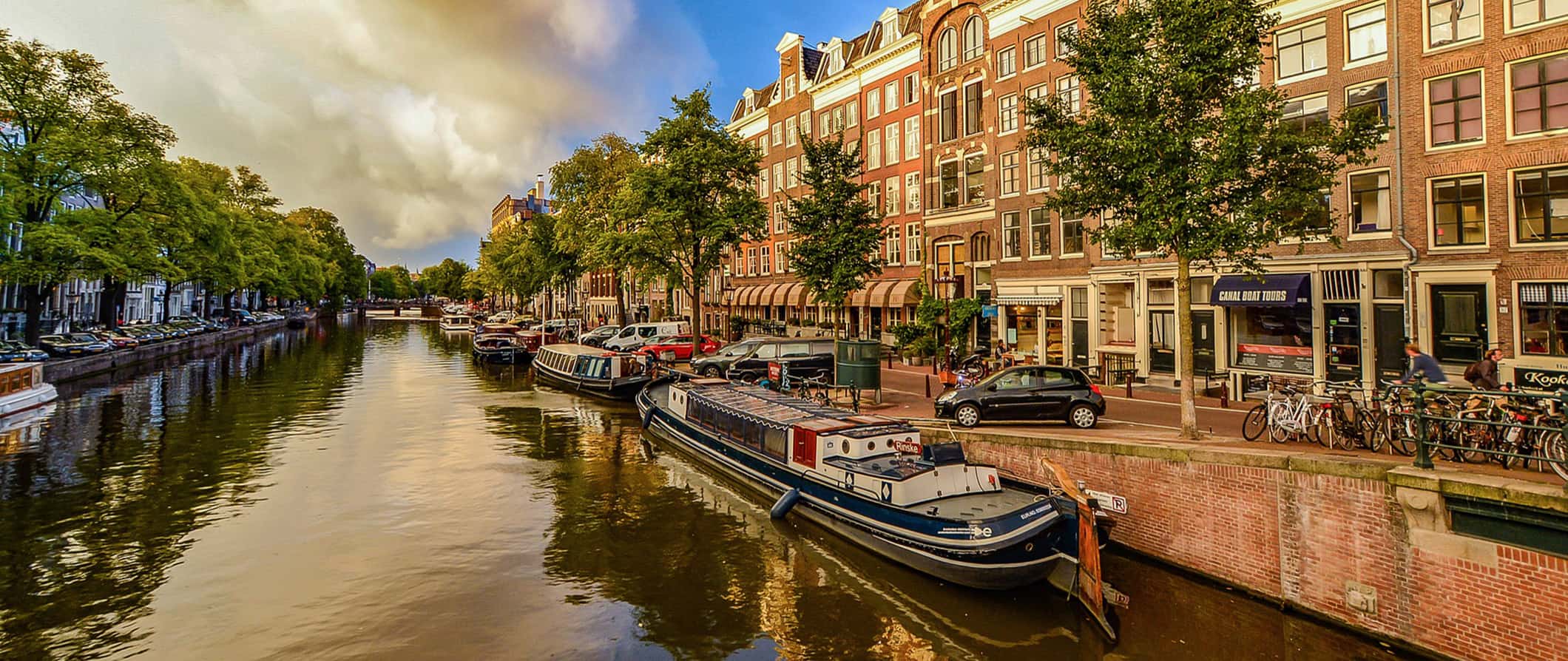
Amsterdam is a city famous for its coffee shops, canals, houseboats, historic architecture, and its Red Light District. Founded in 1275 (supposedly by two fishermen and their dog), the city grew in importance and wealth as Dutch colonies were set up around the world via the Dutch East India Company. Today, it’s one of the most popular destinations in Europe .
While the Red Light District put the city on the map, travelers have since realized that there is much more to Amsterdam than meets the eye. Here you’ll find dozens of art museums, beautiful parks, wonderful outdoor cafes, lots of history, and a love of life here. This city is by far one of the most beautiful in the world. There’s nothing like cruising around the canals on a sunny day or relaxing in Vondelpark with a good book!
I briefly lived in Amsterdam years ago and I can tell you the best of Amsterdam is found outside the city center in the smaller neighborhoods with their quiet charm and canal-side cafes. Don’t hesitate to wander and get lost in this city. You’ll be pleasantly surprised by what you discover.
This Amsterdam travel guide can help you plan your trip to what remains one of my favorite cities in the world.
Table of Contents
- Things to See and Do
- Typical Costs
- Suggested Budget
- Money-Saving Tips
- Where to Stay
- How to Get Around
- How to Stay Safe
- Best Places to Book Your Trip
- Related Blogs on Amsterdam
Top 5 Things to See and Do in Amsterdam
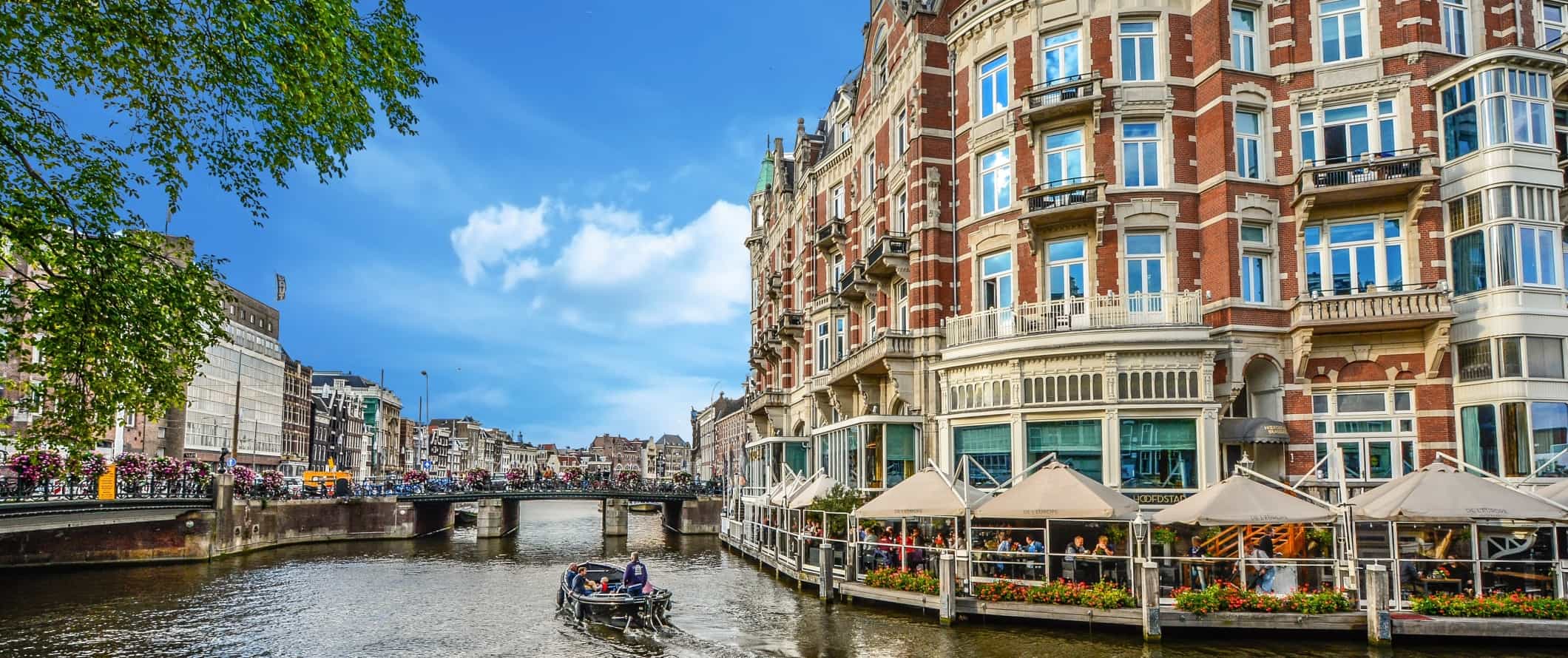
1. Visit the Van Gogh Museum
This museum is home to hundreds of incredible Van Gogh paintings alongside an excellent biography of his life. I can spend hours just staring at the paintings as Van Gogh is one of my favorite artists. It also has paintings by other famous masters of the period like Monet, Manet, and Matisse. It’s one of the best museums in the city. Get your ticket online before you go to avoid waiting in the massive line that always forms. Admission is 20 EUR.
2. Take a canal tour
One of the best ways to see the city is from the canals. Standard canal tours usually cost around 20-25 EUR and cruise around the canals for an hour or two so you can see the sights. There are lots of specialty tours too, such as pizza cruises , wine and cheese cruises , and even booze cruises with unlimited drinks .
If you can though, I suggest you rent your own boat. Eco Boats Amsterdam has small, open-air boats that give you a more intimate experience while still being affordable when shared with friends or other travelers. Prices start at 50 EUR per hour.
3. Explore the Jordaan
This former working-class district is now a maze of trendy cafes, cool shops, and hip restaurants. It’s peaceful place to wander while avoiding the mass of tourists crowding the main streets just a few blocks away. During the summer, it’s a popular spot where locals eat. I absolutely love wandering around here, people-watching while dining, and visiting the weekend farmer’s market. While in the area, be sure to eat at Moeders (traditional Dutch food) and Winkel 43 (get the apple pie).
4. Visit Anne Frank House
This is where Anne Frank and her family hid during World War II. It showcases her childhood, life in the attic, as well as other information about the Holocaust. There’s also a display of her real handwritten diary. It’s a sad and moving place. Admission is 16 EUR. Tickets are only available online and sell out quickly. Every first Tuesday of the month, all tickets for the following month become available, so be sure to snag yours as soon as possible (there’s no waiting list). The museum is usually quite crowded, so if you’d like a more in-depth experience, take this Anne Frank walking tour , which is an excellent alternative option, as you get to learn about Anne Frank’s life, the Dutch Resistance, and Jewish life during World War II from an expert local guide.
5. Hang out in Vondelpark
Vondelpark was created in 1865 and spans over 48 hectares (120 acres). Amsterdam’s largest and most popular park, it’s a great place to walk, bike, people-watch, or relax, especially after a visit to a local coffee shop. There’s a playground as well as places to play sports. Bring a book, pack some food, and lounge the day away.
Other Things to See and Do in Amsterdam
1. take a free walking tour.
One of the first things I do in a new city is take a walking tour. They’re the best way to orient yourself to the city, learn some history, and find out where the major sights are. I think free walking tours are a wonderful first activity in any city. In Amsterdam, I recommend Free Walking Tours Amsterdam and New Europe . They both run great tours that can get you started on the right foot. Just be sure to tip your guide!
2. Visit the Amsterdam Museum
This museum features a comprehensive history of Amsterdam. It’s big so you need 3–4 hours to really go through it in detail. There are a lot of relics, maps, paintings, and audio-visual displays throughout the museum that bring the city’s history to life. My favorite is the video that shows the growth and construction of the city over time. The museum is located in a former monastery that was also once an orphanage. I can’t recommend this museum enough. It’s one of the best history museums I’ve ever visited. Admission is 20 EUR.
3. See the Tulip Museum
Located in a room inside a tulip shop, this small museum does an interesting job of telling the history of tulips in Holland, including the infamous tulip craze (in the 17th century, tulips became a popular luxury item and cost a fortune…until the bubble burst and they became worthless overnight). It only takes 30–60 minutes and, best of all, it’s never crowded. Admission is just 5 EUR.
4. Tour the Jewish Historical Museum
Located near Waterlooplein and often overlooked for the Anne Frank House, the Jewish Historical Museum tells the history of the prominent and influential Jewish people in Amsterdam. It also has an excellent section on World War II, the Holocaust, and how the Dutch dealt with the guilt of mass deportations after the war. Around 80% of the Jewish population in Amsterdam was killed in the Holocaust, making this an eye-opening museum worth spending time to see. Admission is 17 EUR.
5. See photography at FOAM
This photography museum houses wonderful pictures and sees few crowds despite being in the main part of the city. I really enjoyed all the black and white photographs and the outdoor garden. They change the exhibits all the time so you never know what is going to be on display (but it’s guaranteed to be good). I visit each time I’m in the city. You can check the website to see what’s on during your visit. Admission is 12.50 EUR.
6. Squeeze into the Houseboat Museum
This decorated houseboat provides an interesting glimpse into what living on the canals is like. I walked away with one impression of life on the canals: super neat, but super cramped. With admission at 4.50 EUR, it’s the cheapest museum in town and is worth a quick visit.
7. Explore Oost
The area east of the city has an amazing park, a zoo, and lots of good eateries. Wandering around here, you’ll be hard-pressed to find more than a handful of tourists, most of whom are probably lost. It’s off-the-beaten-path and an underrated part of the city. Also, spend some time hanging out in Oosterpark. I enjoy coming here because it’s far quieter and more peaceful than Vondelpark.
8. Relax in Rembrandt Park
Not to be confused with Rembrandtplein in the city center, this park west of the city is a leisurely place to wander. The area around it is more modern than elsewhere in Amsterdam; it’s a nice contrast to the historic center. You know you are there when signs suddenly stop being printed in English and are only in Dutch!
9. Try the Heineken Experience
While I find this experience to be overpriced and commercial, it’s nevertheless an interesting stop for beer fans. Here you’ll get an overview of the company, a few samples, and some silly games to play. Note that this isn’t an actual working brewery, just a place where you can learn a lot about one of the world’s most popular beer brands. Admission is 21 EUR and the price includes two beers. You can also get a joint ticket online for both the Heineken experience and a canal cruise .
10. See the windmills
The Dutch are famous for their windmills and setting out on an adventure to visit the windmills surrounding Amsterdam is a great way to take in the city. There are eight in total – most of which are in Amsterdam West. De Gooyer is the closest to the city center and also happens to be a brewery, making it the perfect place to start (and maybe never leave). It’s just a quick 20-minute train ride from Amsterdam Centraal. Another windmill worth seeing is Sloten Mill, which is a reconstructed mill from 1847 that’s open to the public. Tours last 45 minutes and cost 7.50 EUR. You can also take guided tours to Zaanse Schans , an open-air living history museum that is often known as the windmill town, and where you not only learn about the inner-workings of the windmills but other traditional Dutch crafts, like clog- and cheese-making.
11. Stroll through the Plantage
This district in Amsterdam is comprised of tree-lined boulevards, quintessential canal scenes, several gardens and parks, and the Artis Royal Zoo. It’s a beautiful place to stroll and there’s a lot to see and do if you’re traveling with kids. Beyond the main zoo area, Artis is also host to a zoological museum, a planetarium, and an aquarium. Tickets start at 25 EUR.
12. Drink at the House of Bols
This is one of the most underrated attractions in Amsterdam. Run by the Bols distillery, this is a Dutch gin museum. The self-guided interactive tour takes about an hour and will tickle your senses. Of course, it includes a cocktail at the end as well. It’s a must for gin drinkers and cocktail snobs! Admission is 16 EUR.
13. Visit the Rijksmuseum
The Rijksmuseum is located next to the Van Gogh Museum and, after years of renovation, it’s now beautifully remodeled. The museum features an extensive Rembrandt collection, including the famous painting “The Night Watch.” Besides Rembrandt, there’s also a robust collection of other classic Dutch painters, like Frans Hals and Johannes Vermeer. Over one million works of art, craftworks, and historical objects are kept in the collection so be sure to budget a few hours. Admission is 22.50 EUR. You can book your tickets online in advance to save time and avoiding waiting in the long ticket line.
14. Wander the Museum Van Loon
The Museum Van Loon is a double-sized canal house located on the Keizersgracht canal. Built in 1672, the house was owned by the wealthy Van Loon merchant family who curated a beautiful art collection. Their home is now a museum with period furniture, art, and family portraits. There’s a beautiful garden here too. This off-beat museum is not to be missed. Admission is 12.50 EUR.
15. Shop at the Waterlooplein Flea Market
This open-air market is a giant flea market; everything can be found here. There are around 300 stalls and people sell secondhand clothes, hats, antiques, gadgets, gems, bikes, and more. You can find new items here too. If there’s something you want, it’s probably here. It’s open Monday-Saturday.
16. Take a day trip to Haarlem
Just a quick train (or long bike) ride from Amsterdam, Haarlem is a quiet Dutch town that has a picturesque central church, great outdoor market, and all the beauty of historic Amsterdam with fewer crowds (there are really fun canal cruises to be had here too that I recommend taking). The train costs between 4-8 EUR and takes about 15 minutes. It’s the perfect place to escape for an afternoon.
17. Visit Noord
Leave the city center, take the ferry across the IJ, and visit the up-and-coming area of Noord Amsterdam. In the last few years, a lot of people have moved here (it’s cheap), cool markets and restaurants have opened, and a lot of old industrial land has been reclaimed for public use. It’s the new hip place to be. If you’re into obscure cinema, be sure to visit the famous Eye, Amsterdam’s film museum. Admission is 11.50 EUR.
18. Read at the Amsterdam Library
The city’s library is a beautiful modern building built in 2007. It’s gigantic, overlooks the IJ, and has a wonderful top-floor cafe for impressive views of the city. It’s one of my favorite places to relax in the city. It’s quiet, peaceful, and there’s nothing like reading a good book with a great view!
19. Eat your way around Foodhallen
Located in Amsterdam West, this place is what the name implies — a food hall! Located in a refurbished tram depot, this indoor food hall has various vendors serving a variety of delicious food. Bring an appetite!
20. Explore the Red Light District
Unsurprisingly, Amsterdam’s Red Light District is one of the city’s main draws. Though much tamer than in previous years, the Red Light District manages to balance sex and seediness with being a major international tourist attraction. While it’s worth seeing, I’d keep your time here brief. It’s quite calm and quiet during the day, but at night the area is bursting with drunken revelers and gawking tourists that clog the sidewalks. Even if it’s not your scene, I’d still make sure to see the area with your own eyes at least once. It’s certainly unique!
21. See the Erotic Museum and the Amsterdam Sex Museum
Tucked away in an old warehouse in the Red Light District, the Erotic Museum (7 EUR) highlights eroticism in all its various forms throughout the ages. It has sculptures, paintings, drawings, photographs, and other artwork. And, of course, there is a gift shop if you want a more unique souvenir from the city. The Amsterdam Sex Museum (9 EUR) is the more serious museum and is much more informative than the Erotic Museum (but also a little less fun). It was the world’s first sex museum, having opened in 1985. It highlights the history of sexual views and norms, as well as the lives of some of the world’s most sexually famous individuals (like the Marquis de Sade).
22. Take a Food Tour
One of the highlights of any trip for me is getting to eat my way around a new city. Food is an important part of every culture, and it’s something I’m always happy to splash out on when given the chance. If you’re looking to learn more about Amsterdam’s food scene and sample some of the city’s best offerings then I suggest taking a food tour. Not only do you get to try amazing foods but you learn a ton about their history, how they’re made, and how the food culture here has evolved. Two companies worth checking out are Hungry Birds and Secret Food Tours . Tours with both companies are around 90 EUR.
23. See the Museum Amstelkring
Hidden inside a 17th-century canal house, this is one of the most interesting churches I’ve ever been to. Ons’ Lieve Heer op Solder (“Our Lord in the Attic”) is a clandestine Catholic church that was secretly built during Protestant rule on the 3rd floor of a regular house (it was never really a secret, but since it was out of sight the authorities didn’t crack down on them too harshly). Built in the 1660s, the church has a beautiful drawing room and the furnishings and artifacts make this one of the best 17th-century rooms still intact. Admission is 14 EUR.
24. Learn About Drugs at the Hash, Marihuana & Hemp Museum
No trip to Amsterdam is complete without learning a little bit about drugs. This museum (which has a sister museum in Barcelona) is full of information about the historical and modern use of cannabis. It covers all the medicinal, religious, and cultural uses of the plant and focuses on how hemp can be used for all sorts of beneficial agricultural, consumer, and industrial products. It’s actually really educational! Admission is 9 EUR.
25. Do a bike tour
Bikes are to Amsterdam like wine is to Bordeaux. The locals love to bike everywhere and there are supposedly more bikes than people in the city. Bike usage has skyrocketed in the past two decades and locals collectively cycle over 2 million kilometers every day! If you want to explore the way the locals do, take a bike tour. Mike’s Bike Tours is the best company to use, whether for a tour or to rent a bike on your own. Not only do they offer city tours but they also offer bike tours of the surrounding countryside as well. Tours start at 34 EUR and last around 3 hours.
26. Browse the Stedelijk Museum
I’ll be honest: I don’t like modern art. It’s just not my cup of tea. But if you do, this is the place in the city to see it. Opened in 1874, the museum is home to over 90,000 items including works by Jackson Pollock and Andy Warhol. The exhibitions cover paintings, drawings, graphic design, sculptures, sound, and installations. To be fair, there is a ton of variety here — it’s just not my favorite style. But definitely check it out if you’re an art fan! Admission is 20 EUR.
27. Take an Alternative Art Tour
Amsterdam is home to some incredible street art. You’ll see it all over while you explore, but if you really want to appreciate it and learn about the alternative art scene in Amsterdam then take a tour. Alltournative Amsterdam runs an amazing, insightful tour where you can learn all about the alternative arts while getting to see the best murals in the city. All the people I took on the tour loved it! Tours start at 20 EUR.
28. Explore Micropia
Micropia is a “zoo” home to all sorts of microbes and bacteria. It’s super educational as you can learn about all the invisible microbes that we interact with day to day (you can also scan yourself to see what actual bacteria and microbes are on you right then and there). It’s a neat place to visit with kids. Admission is 17.50 EUR.
29. Visit Museum Vrolik
This quirky museum is home to one of the largest collections of human (and animal) deformities. The collection dates back to the 19th century and the first quarter of the 20th century and has around 150 different items, including creepy jars holding fetuses, human and animal skeletons, and even the remains of a pair of conjoined twins. It’s one of the weirdest offbeat things to do in Amsterdam . Admission is 7.50 EUR.
For more information on other cities in The Netherlands, check out these guides:
- The Hague Travel Guide
- Rotterdam Travel Guide
- Utrecht Travel Guide
Amsterdam Travel Costs
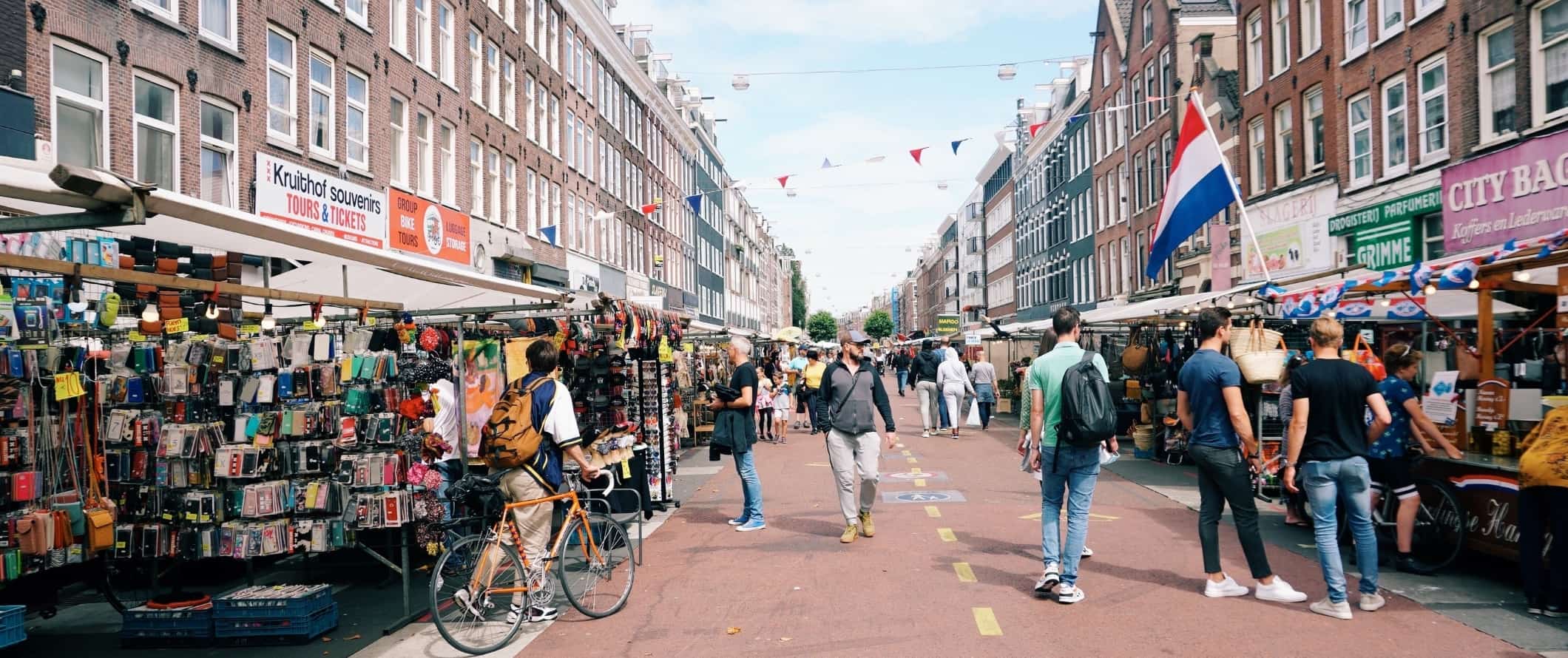
Hostel prices – If you want a centrally-located hostel, expect to pay between 18-30 EUR per night for a bed in a dorm with eight or more beds. A 4-6-bed dorm costs upwards of 30-50 EUR per night. Prices are fairly consistent all year round.
A private twin room with an en suite bathroom starts at 85-115 EUR per night. Free Wi-Fi is standard but only a few hostels have self-catering facilities. Only a couple offer free breakfast.
Budget hotel prices – Budget two-star hotels start at 80 EUR per night (most average around 125 EUR), though there are a few new pod hotels in Amsterdam where you can get a single pod for around 60 EUR. Expect basic amenities like free Wi-Fi, a TV, and a coffee/tea maker.
Airbnb is available around the city, although it has become more tightly regulated in recent years. A private room starts at 80 EUR per night while an entire apartment averages around 175 EUR per night (though you can find plenty of apartments under 150 EUR per night if you book early).
Food – Dutch cuisine typically involves lots of vegetables, bread, and cheeses (gouda originated here). Meat, while historically not as prominent, is a staple of dinner meals. Breakfast and lunch usually involve open-faced sandwiches, often with cheeses and cold cuts. Dinners are very much a “meat and potatoes” meal, with meat stews and smoked sausage being two popular choices. For those with a sweet tooth, the stroopwafel (a waffle cookie with a syrup filling) is the go-to choice, though apple tarts/pies are also local favorites.
Cheap food (like burgers and fries) at the famous FEBO costs around 5-6 EUR, but don’t expect anything fancy (FEBO is Dutch drunk food). Other street food like pizza slices, shawarma, and falafel costs between 3-8 EUR.
There are plenty of budget-friendly fast-food restaurants in Amsterdam, ranging from McDonald’s to Maoz to Wok to Walk (which is by far the best). Combo meals (think McDonald’s) here cost around 9-10 EUR. Many cafes in the city offer prix-fixe lunch specials for between 10-15 EUR.
Mid-range restaurant meals start around 35-40 EUR for a three-course meal with a drink. Vegetarian and pasta dishes start from 12 EUR, and a beer to go with it costs about 5 EUR.
In a high-end restaurant, a five-course or seven-course menu costs around 80-100 EUR, while a glass of wine to go with it is about 6 EUR.
A cappuccino/latte is 3.50-4 EUR and a bottle of water is around 2 EUR.
For restaurants, I love Cafe de Jaren, Pancakes, Modoers, Café Papeneiland, and Burger Bar.
If you cook your meals, expect to pay 50-60 EUR per week for groceries that include pasta, vegetables, chicken, and other basic foodstuffs.
Backpacking Amsterdam Suggested Budgets
If you’re backpacking Amsterdam, expect to spend about 60 EUR per day. This budget covers staying in a hostel dorm, taking public transit, cooking most of your meals, limiting your drinking, and doing free activities like walking tours and lounging in the parks. If you plan on drinking, add at least 5-10 EUR per day to your budget.
A mid-range budget of about 165 EUR covers staying in a budget hotel or private Airbnb, eating out at cheap local restaurants, having a few drinks, taking the occasional taxi to get around, and doing more paid activities like visiting museums or taking a food or art tour.
On a “luxury” budget of about 280 EUR or more per day, you can stay in a hotel, eat out whenever you want, drink as much as you’d like, take more taxis, rent a bike or car for exploring outside the city, and do whatever tours and activities you want. This is just the ground floor for luxury though. the sky is the limit!
You can use the chart below to get some idea of how much you need to budget daily, depending on your travel style. Keep in mind these are daily averages – some days you spend more, some days you spend less (you might spend less every day). We just want to give you a general idea of how to make your budget. Prices are in EUR.
Amsterdam Travel Guide: Money-Saving Tips
Amsterdam is one of the most popular tourist destinations in Europe — and one of the most expensive. Every year prices go up, especially now, post-COVID. Fortunately, a visit here doesn’t have to break the bank because there are a lot of ways to save money in Amsterdam:
- Get the I Amsterdam Pass – This pass offers free entrance to most of the major museums and attractions as well as free public transportation. If you’re going to be bouncing between museums a lot, get this card. The pass starts from 65 EUR per day.
- Drink in hostels – Hostels have the best drink deals in the cities. Even if you aren’t staying at them, most have bars open to the public where you can get 2 EUR beers and other drink specials. Belushi’s Bar at The Winston is very popular among locals too.
- Get the Museumkaart (Museum Card) – Good for an entire year, this card gets you into museums in Amsterdam and beyond for only 64.90 EUR. With the Museum Card, you get access to dozens of museums in Amsterdam and hundreds throughout the Netherlands. You can buy it in select museums, and it’s a good option if you plan on spending an extended amount of time in the Netherlands.
- Take a free walking tour – If you want an overview of the city, take one of the free walking tours. The biggest one is offered by New Europe Tours and will give you a solid introduction and overview. Just be sure to tip!
- Grab an Amsterdam Nightlife Ticket – This ticket is valid for two days or seven days and costs 10-20 EUR. It gets you unlimited access to eight clubs, a welcome drink at five of the clubs, access to the Holland Casino, discounts on your Uber ride, and more. If you’re going to party in Amsterdam, this nightlife ticket definitely cuts down the cost.
- Hire your own boat – Instead of taking an expensive canal cruise, hire your own boat. If you have three or four people, it works out to be about 20 EUR a piece and you can bring alcohol, food, or smoke on it. Boaty Rentals (also known as Amsterdam Rent A Boat) has great options.
- Eat on the cheap – Febo, Walk to Wok, and Maoz are all cheap places to get food. Moreover, cafes in the city offer prix-fixe lunch specials for between 10-15 EUR. If you’re going to eat out, lunch is the best time to do it in Amsterdam!
- Cook your own food – Dutch food isn’t going to win any culinary awards and eating out in the city isn’t cheap. Head to the supermarket instead and cook your meals. You’re not missing out on anything and you’ll save a ton.
- Stay with a local – Couchsurfing is a service that lets travelers stay with locals for free. Not only do you get a free place to stay, but you also get to connect with a local who can share their insider tips and advice. Since a lot of travelers use this service, make your requests for hosts early.
- Save money on rideshares – Uber is cheaper than taxis and is the best way to get around a city if you don’t want to wait for a bus or pay for a taxi.
- Attend a free festival – During the summer, everyone stays outside all day and there are tons of events happening. Check the local tourism office for a list of free concerts, festivals, shows, and markets. Once the weather gets warm, the social calendar fills up and much of it is free!
- Bring a water bottle – The tap water here is safe to drink so bring a reusable water bottle to save money and reduce your plastic use. LifeStraw is my go-to brand as their bottles have built-in filters to ensure your water is always clean and safe.
Where to Stay in Amsterdam
Amsterdam is a big city and there are tons of hostels here. Here are my suggested budget-friendly places to stay:
- Euphemia Old City Canal Zone
- Meininger Amsterdam City West
- Hostel Van Gogh
- StayOkay Amsterdam Vondelpark
- The Flying Pig Downtown
How to Get Around Amsterdam
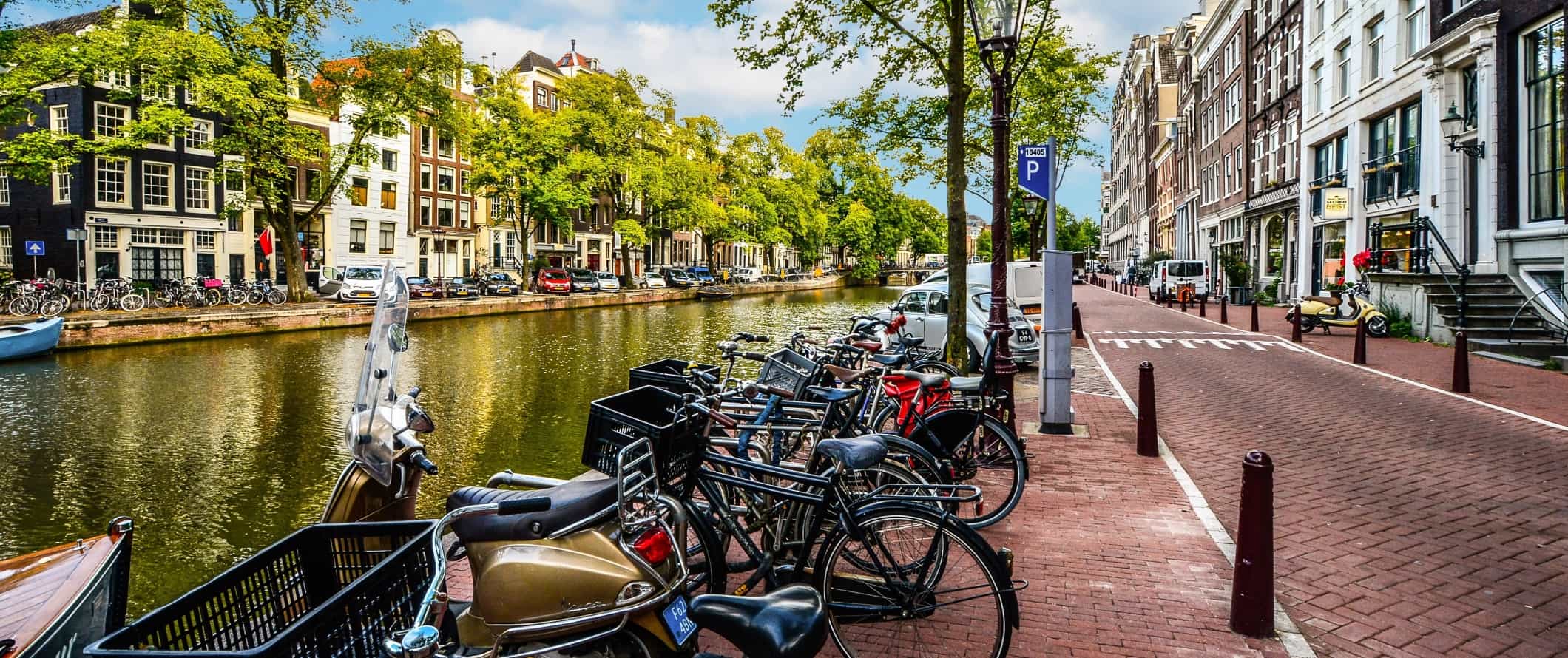
Public transportation – Amsterdam has an efficient system of buses, trams, and a metro that can get you anywhere in the city. Getting around the city is easy — you just need a ticket card (cash fares are not available). You can buy disposable ticket cards for single trips or reloadable cards that you can refill as needed.
Single fares start at 3.20 EUR, though day passes are a much better idea. You can get unlimited travel around the city with the GVB Transportation Multi-Day Ticket . It’s the best way to explore Amsterdam on a budget!
Tickets are available from drivers and ticket sellers, tourist offices, and kiosks. If you download the GVB app it saves you from going to a ticket machine or a counter.
You can also get unlimited access to local public transportation with the I Amsterdam City Card . I highly recommend this card if you’re going to be seeing a lot of museums.
Bicycle – Amsterdam is one of the best cycling cities in the world and bike rentals here are plentiful and affordable. You can rent bikes starting around 10-15 EUR per day.
Taxi – Don’t take taxis here. They are way too overpriced and the city is small enough to walk around. And, if you don’t feel like walking, public transportation goes everywhere. If you do need a taxi, prices start at 5.25 EUR and go up by 2.40 EUR per kilometer.
Ridesharing – Uber is available in Amsterdam but, again, public transportation goes everywhere and is cheaper.
When to Go to Amsterdam
Amsterdam is busy year-round but its peak season is July and August. The average daily summer temperature in Amsterdam is around 22°C (72°F), but it can get a lot hotter than that. This is when the city is packed so expect crowds, waits, and full hostels and hotels. If you’re visiting during this time, book your stay in advance.
If you come between mid-April and mid-May, you can see the tulip fields in bloom just beyond the city. The weather during this time is still nice, though you might get a bit of rain so bring a rain jacket.
Overall, I think late spring and early fall are the best times to visit as you beat the heat and the crowds so there’s no mad dash to book everything early. The weather is temperate so you can still walk everywhere too.
The average daily temperature in the winter is 7°C (45°F), though the Christmas season is a really lovely time to visit as the city lights up with markets and festivities. Beyond that, I wouldn’t suggest visiting in the winter.
How to Stay Safe in Amsterdam
Amsterdam is an incredibly safe place to visit. Pick-pocketing is going to be your biggest concern and it frequently happens on crowded public transit. Keep your possessions secure at all times and make sure your valuables are tucked away just to be safe. Don’t flaunt your valuables either.
As a notorious party city, it’s also easy for thieves to take advantage of drunk tourists at night. Keep your belongings close and always keep an eye on your drink. Don’t accept drinks from strangers and try not to get super drunk just to be safe.
The Red Light District has become more dangerous in recent years, with illegal drugs and violent crime on the rise. Keep an extra eye out while you are there.
There are a few common scams in Amsterdam, such as people trying to sell you public transit tickets that have already been used. Be wary of purchasing a really cheap bike from someone off the street as well as it likely means it’s stolen. You can read about other common travel scams to avoid here .
Solo female travelers should generally feel safe here. However, the standard precautions apply (never leave your drink unattended at the bar, never walk home alone at night intoxicated, etc.), especially as this is a party city. Definitely watch your drinks. There are a lot of solo female blogs out there that can provide more specific tips based on their experience.
If you experience an emergency, dial 112 for assistance.
Always trust your gut instinct. Make copies of your personal documents, including your passport and ID. Forward your itinerary along to loved ones so they’ll know where you are.
The most important piece of advice I can offer is to purchase good travel insurance. Travel insurance protects you against illness, injury, theft, and cancellations. It’s comprehensive protection in case anything goes wrong. I never go on a trip without it as I’ve had to use it many times in the past. You can use the widget below to find the policy right for you:
Amsterdam Travel Guide: The Best Booking Resources
These are my favorite companies to use when I travel. They consistently have the best deals, offer world-class customer service and great value, and overall, are better than their competitors. They are the companies I use the most and are always the starting point in my search for travel deals.
- Skyscanner – Skyscanner is my favorite flight search engine. They search small websites and budget airlines that larger search sites tend to miss. They are hands down the number one place to start.
- Hostelworld – This is the best hostel accommodation site out there with the largest inventory, best search interface, and widest availability.
- Booking.com – The best all around booking site that constantly provides the cheapest and lowest rates. They have the widest selection of budget accommodation. In all my tests, they’ve always had the cheapest rates out of all the booking websites.
- Get Your Guide – Get Your Guide is a huge online marketplace for tours and excursions. They have tons of tour options available in cities all around the world, including everything from cooking classes, walking tours, street art lessons, and more!
- SafetyWing – Safety Wing offers convenient and affordable plans tailored to digital nomads and long-term travelers. They have cheap monthly plans, great customer service, and an easy-to-use claims process that makes it perfect for those on the road.
- LifeStraw – My go-to company for reusable water bottles with built-in filters so you can ensure your drinking water is always clean and safe.
- Unbound Merino – They make lightweight, durable, easy-to-clean travel clothing.
- Top Travel Credit Cards – Points are the best way to cut down travel expenses. Here’s my favorite point earning credit cards so you can get free travel!
- BlaBlaCar – BlaBlaCar is a ridesharing website that lets you share rides with vetted local drivers by pitching in for gas. You simply request a seat, they approve, and off you go! It’s a cheaper and more interesting way to travel than by bus or train!
Amsterdam Travel Guide: Related Articles
Want more info? Check out all the articles I’ve written on backpacking/traveling the Netherlands and continue planning your trip:
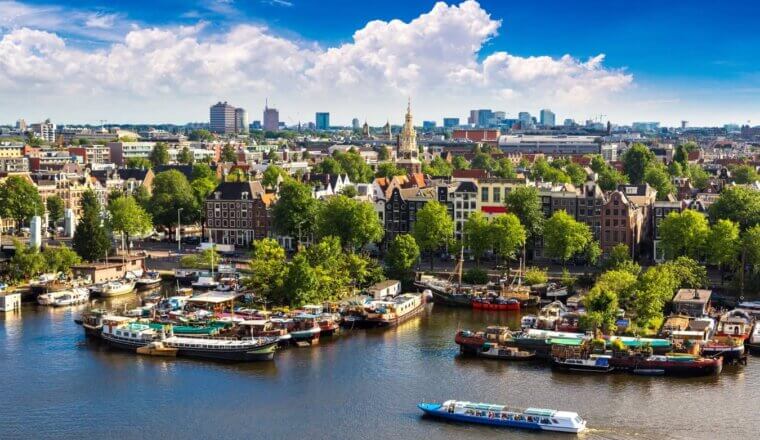
The 8 Best Hotels in Amsterdam
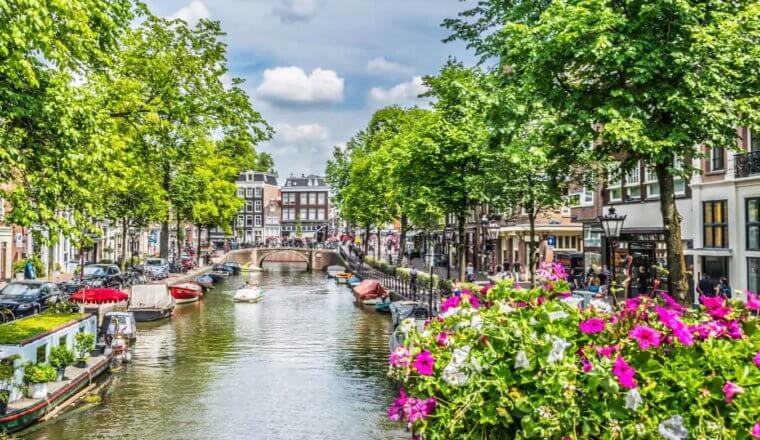
The Best Walking Tours in Amsterdam
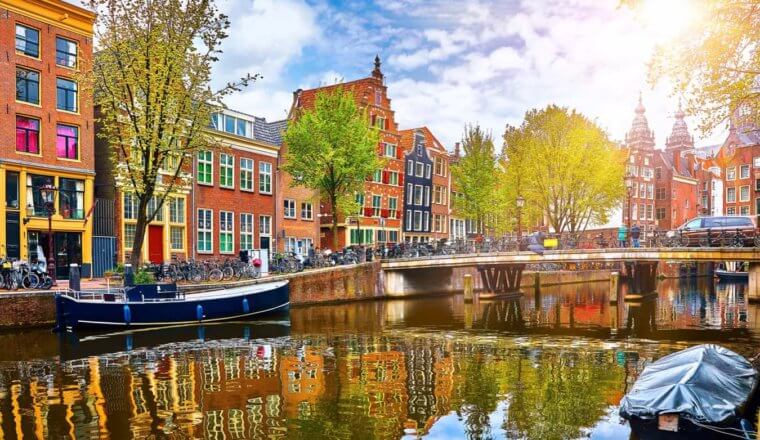
Where to Stay in Amsterdam: The Best Neighborhoods for Your Visit
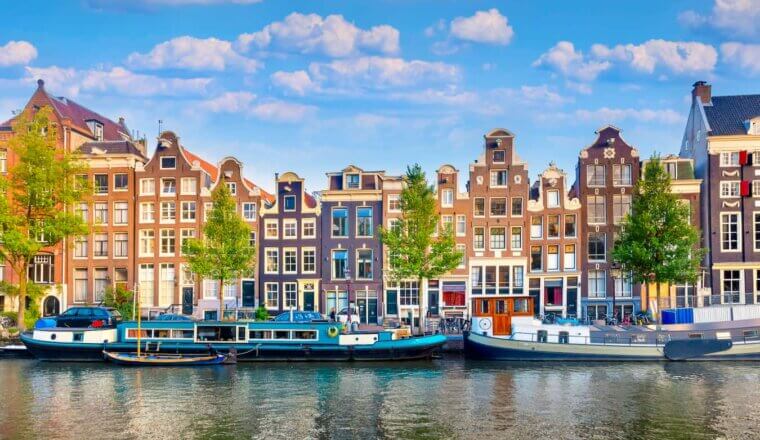
The 34 Best Things to See and Do in Amsterdam
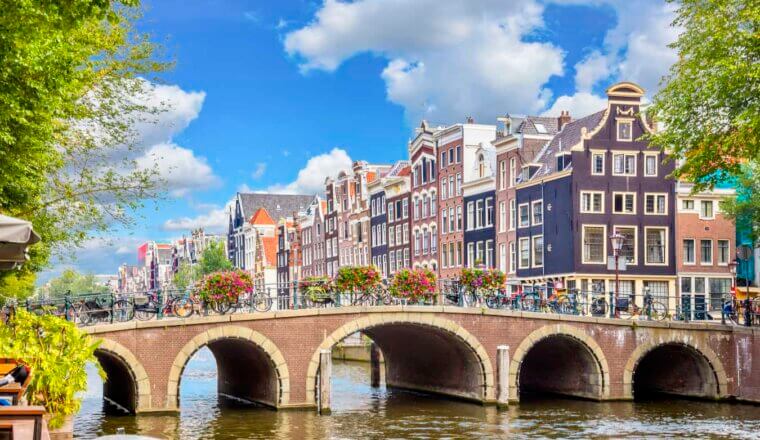
The 9 Best Hostels in Amsterdam
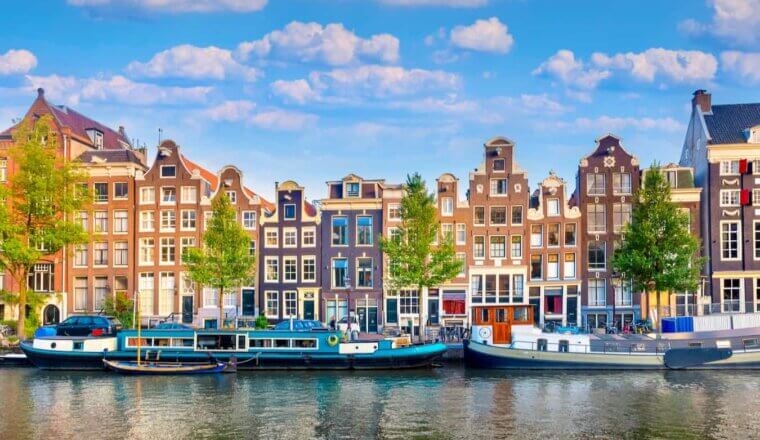
My Suggested 3-5 Day Itinerary for Visiting Amsterdam
Get my best stuff sent straight to you, pin it on pinterest.
- Where To Stay
- Transportation
- Booking Resources
- Related Blogs

Travel Guide
- Things to Do
- Best Hotels
- Things to See
- Best Restaurants
- Best Nightlife
- Getting Around
- Visitor Information
- Entry Requirements & Customs
- Sustainable Travel & Ecotourism
- Calendar of Events
- Health & Safety
- Orientation
- Getting There
- Neighborhoods in Brief
- Escorted & Package Tours
- Tips for Families
- Tips for Gay and Lesbian Travelers
- Tips for Senior Travelers
- Tips for Single Travelers
- Tips for Student Travelers
- Tips for Travelers with Disabilities
- Tips for Women Travelers
- Staying Connected
- Organized Tours
- Walking Tours
- Active Pursuits
- Spectator Sports
- Suggested Itineraries
Money in Amsterdam
If you are used to the prices in New York and London, Amsterdam won't seem too out of whack. But opportunities for scoring genuine bargains run a thin gamut from few-and-far-between to nonexistent. Remember, the Dutch have for centuries been consummate traders and middlemen. You need only look at how well-appointed their country is to appreciate how good a job they've done extracting money from foreigners.
In your favor is that the Dutch themselves display an almost proverbial reluctance to unnecessarily part with a euro. A sound rule of thumb is that if you lodge, dine, and entertain yourself in the same places where "ordinary" Dutch do, you can limit financial damage.
The European euro (€) is the currency in the Netherlands. There are 100 euro cents to each euro. The euro coins are: .01€, .02€, .05€, .10€, .20€, .50€ (1, 2, 5, 10, 20, and 50 euro cents), 1€, and 2€. The euro notes are 5€, 10€, 20€, 50€, 100€, 200€, and 500€.
Holland does not produce its own 1 and 2 euro cent coins (except for commemorative issues), and prices in the country are rounded to the nearest 5 cents. The 200€ and 500€ notes are pretty much unusable because few businesses accept them.
Frommer's lists exact prices in the local currency. However, rates fluctuate, so before departing consult a currency exchange website such as www.xe.com to check up-to-the-minute rates.
The Cirrus (tel. 800/424-7787; www.mastercard.com ) and PLUS (tel. 800/843-7587; www.visa.com ) networks span the globe; look at the back of your bank card to see which network you're on, then check online for ATM locations in Amsterdam. Be sure you know your personal identification number (PIN) and daily withdrawal limit before you depart. Note: Remember that mody banks impose a fee every time you use a card at another bank's ATM, and that fee can be higher for international transactions than for domestic ones. In addition, the bank from which you withdraw cash may charge its own fee. For international withdrawal fees, ask your bank.
If you have a five- or six-digit PIN, be sure to obtain a four-digit number from your bank to use in Amsterdam. Some cards with five- or six-digit PINs might work, but this depends on which bank you're with. The best advice is still to get a four-digit number from your bank.
Credit Cards
Credit cards are not as commonly accepted in Amsterdam as they are in the U.S. and Britain. Many restaurants and shops in the city -- and some hotels -- don't accept them at all. Some establishments tag on a 5% charge for card payment. Visa and MasterCard (also known as Eurocard in Europe) are the most widely used cards in Holland. American Express is often accepted, mostly in the middle- and upper-bracket category. Diners Club is not as commonly accepted as American Express.
Beware of hidden credit card fees while traveling. Check with your credit or debit card issuer to see what fees, if any, will be charged for overseas transactions. Fees can amount to 3% or more of the purchase price. Check with your bank before departing to avoid any surprise charges on your statement.
In Holland, you'll rarely (perhaps never) come across a business that uses the old swipe system for authorizing credit card payments. Instead, payments will either be authorized by a chip system in the card and the cardholder's signature, or by chip-and-PIN, with a four-digit personal identification number replacing the signature. An additional complication is that many card-accepting machines and businesses in Holland, in particular those like parking machines, train ticket machines, self-service gas (petrol) stations, and small shops, take the local Chipknip stored-value cards. Foreign visitors may be obliged to use their cards to a certain extent just for withdrawing funds from bank ATMs, and paying with old-fashioned cold, hard cash.
Note : This information was accurate when it was published, but can change without notice. Please be sure to confirm all rates and details directly with the companies in question before planning your trip.

- All Regions
- Australia & South Pacific
- Caribbean & Atlantic
- Central & South America
- Middle East & Africa
- North America
- Washington, D.C.
- San Francisco
- New York City
- Los Angeles
- Arts & Culture
- Beach & Water Sports
- Local Experiences
- Food & Drink
- Outdoor & Adventure
- National Parks
- Winter Sports
- Travelers with Disabilities
- Family & Kids
- All Slideshows
- Hotel Deals
- Car Rentals
- Flight Alerts
- Credit Cards & Loyalty Points
- Cruise News
- Entry Requirements & Customs
- Car, Bus, Rail News
- Money & Fees
- Health, Insurance, Security
- Packing & Luggage
- -Arthur Frommer Online
- -Passportable
- Road Trip Guides
- Alaska Made Easy
- Great Vacation Ideas in the U.S.A.
- Best of the Caribbean
- Best of Mexico
- Cruise Inspiration
- Best Places to Go 2024
Your Trip to the Netherlands: The Complete Guide
Best Time to Visit
Weather & Climate
Airports in the Netherlands
Getting Around the Netherlands
Cities to Visit
Complete Guide to Amsterdam
Amsterdam's Public Transportation
Essential Dutch Phrases
One Week in the Netherlands
48 Hours in Amsterdam
Getaways From Amsterdam
Top Things to Do in the Netherlands
Castles to Visit in the Netherlands
Best Things to Do in Amsterdam
Things to Do With Kids in Amsterdam
Shopping in Amsterdam
Amsterdam's Top Markets
Live Music in Amsterdam
Amsterdam's Must-Visit Museums
Guide to the Keukenhof Flower Gardens
Must-Try Food in the Netherlands
Craft Beer in the Netherlands
Heineken Experience
Amsterdam's Top Restaurants
Nightlife in Amsterdam
Exchanging Your Currency in Amsterdam
Don't expect to rely on U.S. dollars in Amsterdam: as a member of the eurozone , the Netherlands is one of 19 countries in the European Union that's adopted the euro as its official currency . The value of the euro has fluctuated considerably since it was first introduced in 2002 - from parity with the dollar in 2002, to $1.60 2008, and back to near-parity in 2015. But no matter the relative value of the euro to the dollar, it's wise to seek out the best conversion rate ahead of time.
Recommended Amsterdam Currency Exchange
ATM machines typically offer the most favorable rates for travelers who want to convert their dollars to euros. In this case, the card holder's bank sets the conversion rate; certain fees may or may not apply. Some U.S. banks don't levy conversion fees for international withdrawals, whereas others do (usually 3% or less); be sure to check with your bank beforehand. While the majority of Dutch banks do not levy ATM fees, some U.S. banks deduct several dollars for each transaction outside their network, and possibly extra for international withdrawals. Some credit card companies also allow cardholders to withdraw cash advances from ATMs, but cash advance fees usually apply. ATMs, or geldautomaten in Dutch, are widely available across the Netherlands as well as at Schiphol Airport. (Note that not every ATM accepts international cards, so don't panic if your card is rejected - but do have a Plan B lined up just in case; see below for advice.)
Currency exchange services are another option, but their rates are usually less favorable than ATMs. The best currency exchange service in Amsterdam is not a widespread chain, but a business with just one conveniently located office: Pott Change , at Damrak 95. Just steps from Dam Square and minutes on foot from Amsterdam Central Station, Pott Change consistently offers the best exchange rates in town.
Not Recommended
While GWK Travelex offices are situated at convenient points across the country, the company has a reputation for unfavorable rates - the worst of which are to be found at the company's several Schiphol Airport locations. Beside Schiphol, GWK Travelex has offices at Eindhoven Airport , Rotterdam Airport, and almost every major railway station in the country, and their services are widely used out of sheer accessibility.
Nevertheless, most visitors would do best to withdraw money directly from an ATM (provided that their banks levy only modest fees or none at all), or at least wait to convert their currency for a better rate at Pott Change.
More Money Tips for Amsterdam Visitors
How to Claim VAT Refunds in the Netherlands : VAT is a consumption tax on products that are set at a substantial 21% in the Netherlands - and non-EU residents don't necessarily have to pay it. Find out how to claim a VAT refund on your purchases in the Netherlands.
Amsterdam Tourist Discount Cards : This trio of tourist discount cards - the I Amsterdam City Card, Amsterdam Holland Pass, and Museumkaart - helps visitors save on (often pricey) attractions and activities in Amsterdam and the Netherlands.
Discount All-Day Train Passes for Intercity Travel: Find discounts on the country's extensive inter-city rail network at some of the country's major chain retailers - sometimes in conjunction with special bonuses such as free meals or admission fees.
Currency Converters
Your Trip to the Czech Republic: The Complete Guide
Caribbean Currency for Travelers
Tips for Changing Your Money Abroad
Currency in Egypt: Everything You Need to Know
Exchanging Currency in France
A Traveler's Guide to the Yen
Cuba Guide: Planning Your Trip
France Guide: Planning Your Trip
The Complete Guide to Currency of the Netherlands
Vital Information for the First-Time Visitor to Thailand
Essential Information About Currencies in Europe
Mérida: Planning Your Trip
Is U.S. Currency Accepted in Canada?
Your Trip to Tulum: The Complete Guide
Seoul Guide: Planning Your Trip

Best Ways To Exchange Currency In Amsterdam
Gerrit Vandenberg
Gerrit shares his love for the Netherlands from his home near Amsterdam, helping thousands plan unforgettable trips to the lowlands. Discover his inspiring journey "From a critical health scare to celebrating Holland's charms" . If you want to send Gerrit a quick message, you can contact him here .
Disclosure: This article has affiliate links. As an Amazon Associate, I earn from qualifying purchases. It costs nothing extra, but you'll help keep my content free. It's a win-win!
WANT TO SAVE THIS ARTICLE?
Enter your email below & I'll send it straight to your inbox!
And each week, I'll send you new tips to plan your Netherlands vacation. If you decide it's not for you (any longer), unsubscribing is always just a click away.

Hi, I'm Gerrit
I enjoy sharing useful tips about the beauty of this county.
Do you need to exchange currency in Amsterdam?
You’re in the right place, as I’ve lived most of my life in the Netherlands , I know where to find the best deals and the places to avoid.
I also have to deal with currency when I travel, which I do often. I’m here to explain the different ways to exchange currency in Amsterdam.
By the end of this article, you will be comfortable with the process of paying and exchanging money in a foreign country.
Plus, I have a few tips on saving money with every method.
But first and foremost, many travelers wonder about the best way to exchange money. I always recommend using a free Wise Multi-Currency Debit Card .
This is the method I always use when I travel and the one I recommend to everybody. It’s hands down the cheapest way to deal with currency when you travel.
The Lowest Priced Debit Card For Travelers
One of my travel hacks is the WISE borderless debit card. This is the most international debit card in the world . Spend abroad with the real exchange rate. I use this card myself for all my overseas trips and saves a lot of money!

The currency used in the Netherlands (Holland) is the Euro. If you live in a country outside the Eurozone, like in America or Great Britain, you must exchange currency in Amsterdam or elsewhere for Euros.
You’ll find more information about the Euro in the frequently asked questions at the bottom of this post. But the main topic of my post today is about the best way to exchange your money.
There are many wrong ways where you will lose a lot of money and only a few good options. This is one of my main Netherlands travel tips .
I don’t know about you, but I rather spend my money on fun activities and not just give it to banks.
PS: Wondering how much to tip in Amsterdam and the rest of the Netherlands? Find out in my post, Tipping in Amsterdam , which includes a helpful calculator!
Below you will find a detailed explanation of the different options, why most lose you money, something we want to avoid 🤬, and which methods are better 😌. Let’s clear up the confusion around exchanging currency.

Different Ways to Exchange Currency in Amsterdam and Beyond
My favorite travel books.
I love how Rick Steves' guidebooks offer a traveler's perspective. This is my favorite Amsterdam guidebook by far! Rating 4.8/5 on Amazon.

Lonely Planet guides have changed but I still enjoy this book, it's pretty and up to date though it's not as hands-on as Rick Steves'.Rating 4.6/5.

Click here for more Netherlands book recommendations . (travel books, art books, language books, and maps)
🚨 Option 1: Use Your Credit Card From Home
When I talk to my readers, I always ask if they thought about the currency before their trip, and still, I’m surprised when I hear: “Oh, I’ll just use my credit cards while I’m there.”
I understand it is the most simple solution. I also know the ads banks broadcast. I’ve heard them all . “With our card, you pay no fees for foreign transactions,” or “With us, you pay no markup on foreign currency.” They often throw in extra perks, like extra points, to sweeten the deal.
Great marketing, often not so great for your wallet . Usually, 9 out of 10, it is either/or. So no fees translate to a (high) markup. Or no markup means a fee is added. Rarely both are waived, this is how they make money , and you lose quite a bit, even with the nice ad saying there are no fees when you travel. Sneaky right?
What does this mean: a fee is usually a fixed amount for every charge or ATM withdrawal in a currency other than your own. This is on top of fees the ATM itself charges.
A markup is usually the commercial (inflated) exchange rate vs. the official (mid-market) rate you see on Google or Yahoo. Those costs add up, entirely out of sight to you. It looks free, but you pay pretty significantly for the privilege.
Before you’re absolutely certain you truly have a card with a good deal, check the fine print and look for fees AND markup. If not clear, ask the card issuer about their foreign exchange fees AND if they use the mid-market rate, if not, how much (%) they add to it.
🔔 Also essential to realize: Credit cards are NOT as well accepted as debit cards and cash in Amsterdam and beyond. Relying on your credit card only will become quite inconvenient quite quickly. Also, you need the contactless option on your card and a pin code for every transaction above a certain amount.
Of the main brands Mastercard and Visa are best accepted. American Express far less, and Discover even less then that. Especially in stores and restaurants AMEX and Discover can be problematic.
Many stores don’t accept credit cards at all. Albert Heijn Supermarkets (the largest chain in the country) does not accept them. Also, small old fashion stores might still be cash-only 🤔. So you want a card that also allows low cost (or better no cost cash withdrawals for those situations.
Option five is better: a specific travel-optimized multi-currency debit card with super low fees for exchanging currency, and free emergercy cash withdrawals. This is how I travel myself.
🚨 Option 2: Exchange Your Currency And Buy Euro Before You Leave
Especially popular with British and Americans is exchanging currency at home from a local bank, post office, or airport.
The advice usually sounds something like: better safe than sorry, and have (some) cash at hand when you arrive. It’s very EXPENSIVE advice . Please don’t do it. Here’s why:
Banks’ exchange rates are terrible on top of their hefty fees. Don’t be fooled by no-commission promotions often seen in the UK. The exchange rate will just be worse. Again always check against the mid-market exchange rate. That is the one you’ll find on Google. Just notice the difference between the two.
How about the benefit of having some local currency when you arrive? There is nothing at Schiphol Airport you can’t pay for with a debit or credit card. You do not need cash in your first hours in the Netherlands. Even for transportation from the airport, you can use a card.
And one of the nicer benefits of option five, my recommended debit card , is that you can, after arrival, withdraw some cash at no extra costs , just as a backup when you’re at a place that doesn’t take cards at all. This is a valuable and helpful perk of this card.
Please don’t exchange cash from home. It’s such a waste of your money. You worked hard for it.
🚨 Option 3: Exchange Euro at the Airport
No matter which airport you travel from, via, or to, exchanging your money at an airport is always a bad idea. It will cost you A LOT of money! It’s the worst option out of all.
Are you wondering why? Just look at those screens that publish the exchange rates at the exchange office. Do you see the massive difference between buying and selling rates? That is what they earn! Plus, the commission and fees they charge on top of that.
Do not be fooled by zero percent commission or free buyback offers. Ultimately, all that matters is how many euros you get for x amount of your currency. After all costs, I promise you it won’t be favorable.
You must know the mid-market rate to know if you get a good deal. That is the one you see on Google. You’ll be shocked to find out how much less an exchange office offers you, especially at an airport.
Be smart and spend your money on more enjoyable things and check out the Wise Borderless Debit card below instead.
Here are more tips for a smooth arrival at Amsterdam Airport Schiphol .
🚨 Option 4: Withdraw Cash From an ATM After Arrival
After all this bad news, this option might seem a cost-effective way to get Euro. Unfortunately, it’s often not. Unless you have the right card.
Most ATMs charge a fee if you are not a customer of them. Then your card issuer might add an ATM withdrawal fee on top of that. And most likely, you will also be hit with an inflated exchange rate higher than the mid-market rate. Often an ATM withdrawal can be nearly as expensive as exchanging at a bureau.
🏧 Here are a few tips when using an ATM to get Euro
- Use a bank card with low ATM fees (and reasonable exchange rates). Our recommended Wise card does precisely that.
- When the ATM asks you to be charged in your currency, like USD, decline, ALWAYS choose Euro.
- Debit cards are usually cheaper than credit cards (but check this).
- Obvious, but still often forgotten: make sure you know your pin code.
- Magnet strips don’t work in Europe. Make sure your card has a chip on the front (or is contactless)
- Tell your bank when you’re traveling, so they can unblock your card for overseas use.
Eight Popular Attractions in Amsterdam

Find more tickets with your favorite provider:
Tiqets | Get Your Guide | Viator | Tours & Tickets
✅ Option 5: Use a Wise Borderless Debit Card
My favorite method to hold my foreign currency is with the Wise Borderless card . This is the card I use, and it has helped me save a lot of money!
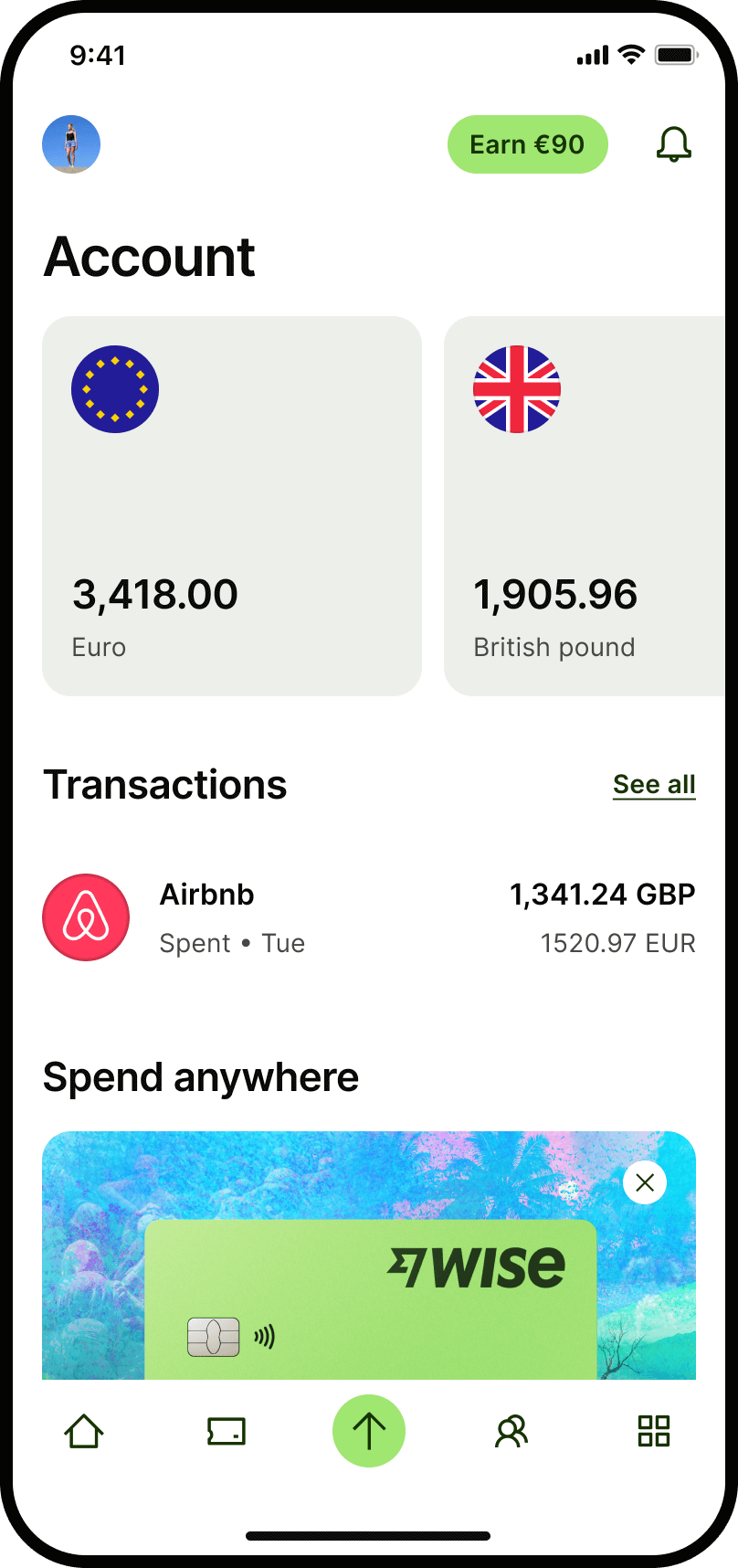
It’s a free account with a free debit Visa and Mastercard. Virtual cards (that you can use with Apple Pay or Google Pay) are free. For a small one-time fee, you can also get a physical card, which I recommend as a backup.
You can hold money in jars . Each jar is a currency. You can activate these, for example, in US dollars, British pounds, and Euros.
You only pay a small fee when you transfer money from one currency to another. Fees vary between payment methods, but they’re always super low cost .
I love how honest their fee structure is— no hidden charges . No monthly fees or maintenance charges either.
Once the funds are converted, you can spend it as a local without extra costs.
On top of that, a few small ATM withdrawals are allowed free of charge each month. If your card is not accepted, having some cash in your pocket is nice.
You can also use this card for online purchases in another currency, like Euro. For example, when purchasing your museum or transport tickets before you leave.
It’s a multifunctional payment card you will quickly appreciate when traveling overseas.
These are the benefits in short:
- There are no hidden fees , just low costs that are communicated upfront.
- J ars for each currency . The card is smart enough to know where you are and which to use.
- No monthly fees or maintenance fees. You pay when you add funds. That’s it.
- You can transfer between currencies if you have multiple currencies in your account.
- Any remaining funds can be easily transferred back into your home currency.
A Borderless account with a debit card is available if you live in the US, the UK, Australia, New Zealand, Singapore, or any country in the EU.
As a bonus, the card itself looks very cool. I often receive comments from people when I use it: “Oh, I like that card!” “Well, thank you very much. I like it too 🤗.”
This Is How Your Wise Borderless Account Works:
When you’re ready to add money, you can transfer the amount from your checking account or credit card to your Wise account. Login to your wise account. Click the currency you want to add (like Euro) via the + button.
You can then fill out how much you would like to convert. It tells you the current exchange rate and the costs (estimate). Then on the next screen, you select a payment method. Here you can see the definite costs.
A direct debit or bank transfer is often cheaper than using your credit card. Once the payment is received, your new currency is added and ready to be spent. It’s that simple.
Getting some cash from an ATM is easy in the Netherlands. Make sure it’s a yellow “Geldmaat.” They won’t charge extra fees and can be found anywhere in banks, railway stations, and often larger chains. Do not use the private ATMs you often see in tourist shops. These add additional costs.
You won’t need that much cash. However, I still advise having €100 in cash , just in case. This is free with the account.
Wise Borderless App
Another excellent benefit of your Wise debit MasterCard® is that it comes with a convenient app on your phone. You can use it to add money to your account with ease. You can see your balance(s) and get instant notifications when you use your card. It’s so helpful!
Wise compared to 5 other US bank accounts and PayPal.

The Lowest Priced And Most Flexible eSIM cards (incl. tethering)
Stop searching for WI-FI; get an affordable eSIM for the Netherlands. From just $4.50 for 1GB, but I recommend at least 10GB . TIP: Get the App for easy top-up.

🟠 Option 6: Change Cash After Arrival in Amsterdam
You can exchange cash currency for euros in the city and the rest of the country. Although outside Amsterdam, it will require some effort. At most train stations in larger cities, you will find a GWK Travelex, to change currency. But again, the rates aren’t favorable. Avoid it if you can.
You’ll also find independent exchange offices in Amsterdam and Rotterdam. Expect poor rates. But there is one exception, Potts Exchange in Amsterdam . I’m not affiliated with them, but they offer relatively good rates, so I want to mention them.
Potts is located on Damrak 95, opposite the Bijenkorf department store. Very central. Their rates are better than most but still expect to lose 3-4% depending on the currency.
The Wise debit card still is the better option. But sometimes you need a currency exchange, so it’s good to know a better option.
Find A Place To Stay In Amsterdam
Find accommodation in Amsterdam for the lowest prices on your favorite platform. What's great about this map is that it shows both Hotels , as VRBO rentals (AirBNB but then cheaper).
Update your (intended) travel dates for accurate prices . TIP: Zoom out on the map (-) in the bottom right corner. This will show more options and availability.
📝 Here is a Money Checklist Before You Leave
- Check ALL fees, charges, and exchange rates other than midmarket rates for all your cards.
- Activate your cards to use abroad before you depart. Also, cards you don’t plan to use: an emergency can happen.
- You’ve checked if your cards have a chip on the front. If not, call your bank. In Europe, these are necessary.
- You know all the PINs for your cards. You need to use your PIN in Europe.
- You’ve opened a free account with Wise (if you’re eligible), ordered your debit card, and added Euros to your jar.
- After arrival in Amsterdam, it’s smart to withdraw €100-€200 in cash from a “Geldmaat” ATM with your (Wise) card.
- Pay for most of your expenses with your Wise debit card or low-fee bank card during your trip.
- Avoid exchange offices if you can. Pott’s might be the exception here.
💬 Frequently Asked Questions About Euros
What bank cards are most common in holland.
The Dutch use their debit cards from a local bank. They don’t use credit cards. Usually, only when they travel. The result is that credit cards are not as widely accepted as elsewhere.
Many places will accept them but also have debit cards and some cash on hand in case they do not.
Are ATMs easy to find in Amsterdam and the rest of the country?
Yes, that is not something you have to worry about. There’s legislation to ensure that a cash machine is available within a short distance from anyone living here. That’s especially important for small villages in the countryside and older people.
You’ll find an ATM anywhere. Usually, those ATMs are not in a bank branch in smaller places. But they are inside a supermarket or a news outlet store. For example, inside an Albert Heijn, Jumbo, Bruna, or Hema. All free ATMs are now branded yellow and called “Geldmaat.”
You’ll also find these ATMs at most railway stations, in shopping malls, local shopping centers, and major attractions like the Efteling, Zoo, et cetera. Just ensure you’re not using a private ATM that is not bright yellow and branded geldmaat.
TIP: Use Google Maps . It has an excellent option for searching for ATMs in an area.

Can I use Traveler’s Cheques in Amsterdam and the Netherlands?
Not that I’m aware of anymore. It will be tough to use them. And if you can, you will be confronted with high exchange fees and costs. Traveler cheques are from another era and not your best option today, like the travel debit card I recommend on this page.
Is the Netherlands on the Euro?
Yes, the Netherlands has been using the Euro since 2002. You can no longer use or exchange guilders if you still have any lying around. Those are now souvenirs. We use Euro only, in Amsterdam and the rest of the Netherlands.
What different coins does the Euro have?
Euros have different coins. They’re divided into cents, just like dollars. One Euro is equal to 100 cents. Coins exist in 1, 2, 5, 10, 20, and 50 cents plus one and two euro coins. The main difference is that the euro has a 2-cent coin and a 20-cent coin; in the US, you have a 25-cent coin.
We no longer use the one- and two-cent coins in the Netherlands. We round the final price you must pay up or down to the nearest 5-cent point.
But in neighboring countries, these coins are used. They won’t be accepted here, so spend them in the country where you got them or take them home as souvenirs.
A fun fact is that euro coins are the same on one side of the coin (front). But on the flipside, they differ depending on which country minted them.
You can collect the prints from every member state. It’s fun to do. Try to guess where each coin is originally from. They are worth the same and can be used anywhere. It’s just trivia.
What different banknotes does the Euro have?
Euro bills have different banknotes. They come in 5, 10, 20, 50, 100, and 200 notes. There was a 500 euro note once, but it is being phased out since ordinary people never use it.
Sometimes, spending 100 and 200 euro bills, even 50 notes, will be challenging. It’s best to have a mix of the smaller notes when possible.
When you withdraw cash from an ATM, you’re often given a choice of which notes you want to receive. Choose the smaller denominations when you can. If you get 50 notes, try to break them at larger stores or use them for higher-priced items.
You can withdraw free cash up to €100 a month with the Wise Debit Travel Card .
What is the Currency Symbol for the Euro?
The currency symbol for the euro is €. It’s not always clear where to place it. In the Netherlands, we always put it in front of the amount. Thus € 100. You can use a space or not.
In neighboring countries, the symbol is often placed behind the amount. This is done in Belgium, Germany, and France, for example. It’s never wrong where you place it.
That would look odd for a Dutch person to see the symbol behind the amount. To us, that would look like something foreign.
Every Coffee ☕️ Counts!
Do you appreciate this article? Consider sending me a coffee ☕️ to support this website’s upkeep. Every contribution matters and is deeply appreciated. Thank you for your generosity !
Would Like My Personal Help?
Planning a trip well is a lot of work and can feel overwhelming.
Know I’m here to help when you need assistance with your Netherlands vacation.
When you book an Itinerary Consultation with me, I help you improve your itinerary and make your trip planning much faster and less stressful. But I also enrich it with my unique insights and tips. Local tips.
Different than a blog article I can with a 1 on 1 session focus on you and your trip alone.
How do you plan to plan to in Amsterdam?
I’d love your thoughts: Will you use your own bankcard from home? Or will opt for a Multi Currency Card?.
Let’s start a conversation 💬.
Read More Handy Travel Tips
- Train Tickets Netherlands: Buy Your NS Train Tickets 2023 🎫
- 6 Tips for Using A Mobile Phone in Amsterdam, Not Just a SIM Card
- How To Choose The Best Amsterdam Sim Card 2023 📲 (EU🇪🇺)
- 12 Incredible Pieces of Rijksmuseum Art Beyond Paintings
2 thoughts on “Best Ways To Exchange Currency In Amsterdam”
I’m a little mad at you, your articles are so good, I have spent two hours reading answers to many of my questions and concerns. You are doing a superb job sharing valuable guidance to make our experience to your country more enjoyable.
This will be my third visit to Amsterdam. We are starting a Viking River Cruise in Amsterdam, and only staying a couple of nights. It’s our 50th Anniversary, and we always wanted to do a river cruise. The cruise ends for us in Budapest. We will stay there for another five days, and fly on to Bucharest for a week, before flying back home.
I believe you have sold me on the Wise card, and will probably apply for my card soon.
I do have a specific question on transportation at AMS. I see there are many options and prices to et to your hotel destination. Sadly, we do not know how to pack, and will have some luxe, so the cheap public transportation will not be practical for us. I did not see, like a big van type vehicle for shuttling us tourist to different hotels in the city center. The van would load up as many as it would hold and go to different hotels dropping off the passengers. Is there anything like that at AMS I can look into?
Again, you have talent structuring your content. Organized, simple, and very informative. If I did not know better, I would think I put this together.
David M Hill – Texas
Thank you for your super kind words David. And happy 50th anniversary. How wonderful. Wise is super handy. I use it all the time myself when I travel outside of the Euro zone. I feel I’m having a Texan week. I just concluded two private tours with two different families from Texas. And both where lovely and a lot of fun to be around with. I’m growing a fondness for Texas 😉
To answer your question there is a hotel shuttle service available that is between a taxi and a bus. But they’re very restrictive with luggage (one 20 kilo bag each). I think you’re better off with this car service booking service where you can arrange a terminal pick up, and choose the type of vehicle you need. For example a larger vehicle.
Hope that helps. Have a wonderful time here! PS applying for a Wise card takes some time, so do it as early as possible. It’s next to free to do so. You only pay a few dollar for a psychical payment card. And then only when you convert currencies to your card.
Leave a Comment Cancel reply
Save my name, email, and website in this browser for the next time I comment.
Currency exchange in Amsterdam
Foreign currency exchange in Amsterdam
Order foreign money online and collect it in amsterdam, our money exchange offices in amsterdam, quick links, customer service, about gwk travelex, customer support, here to help.
This website uses cookies to improve your browsing experience and analyze the use of the website. Learn More

What Currency Is Used in Amsterdam?

The quick answer is the euro. Until 2002 the Netherlands used the Dutch guilder or gulden.
Luckily, those hoarding old guilder notes under the mattress have until 2032 to exchange them for euros at the national De Nederlandsche Bank!
As far as travelers are concerned, euros are what you will be dealing with in Amsterdam, and the rest of the Netherlands and most other countries in Europe.
This post discusses using the euro in Amsterdam based on both my visits there, as well as information from our local tour guides living in Amsterdam.
At the bottom of this post, we include more advice from locals and travelers from our popular Amsterdam Travel Tips Facebook Group.
- What Currency Is Used in Amsterdam
- Cash vs. Credit and Debit Cards
- Exchange Rates
- Exchanging Currency
- Withdrawing Cash From ATMs
- Tips From Locals & Travelers
What Currency is Used in Amsterdam
As stated above, the official currency of Amsterdam and the rest of the Netherlands is the euro, which is the currency for almost all of the European Union (EU) nations.
Euro Banknotes and Coins
- Euro banknotes come in these denominations: €5, €10, €20, €50, €100, €200, and €500.
- Euro coins come in these denominations: 1c, 2c, 5c, 10c, 20c, 50c, €1, and €2.

Here’s something minor - and kind of cool - to take note of when handling euro coins in Amsterdam. All eurozone coins have common imagery, a map of the European Union (EU) along with the denomination of the coin.
Some EU countries have a national side with a traditional or iconic image of the country. Such coins are still euros so no need to fret if you get a coin with the image of a Dutch queen or king!
You can still use these coins in any nation that accepts the euro.
Keep your eyes open for these pretty coins in Germany , Ireland , Greece , Spain , France , Italy , Austria , Portugal , Belgium , Croatia , and even Vatican City !

Cash vs. Credit and Debit Cards
The Netherlands is quite progressive and a majority of transactions are now completed with credit and debit cards.
You could avoid handling a single bit of cash on your entire trip to Amsterdam!
All major establishments and many small ones accept debit and credit cards. Some places do not accept cash!
MasterCard and Visa are the most commonly used credit cards in Europe, followed by American Express. You may also use Apple Pay and Google Pay in many establishments.
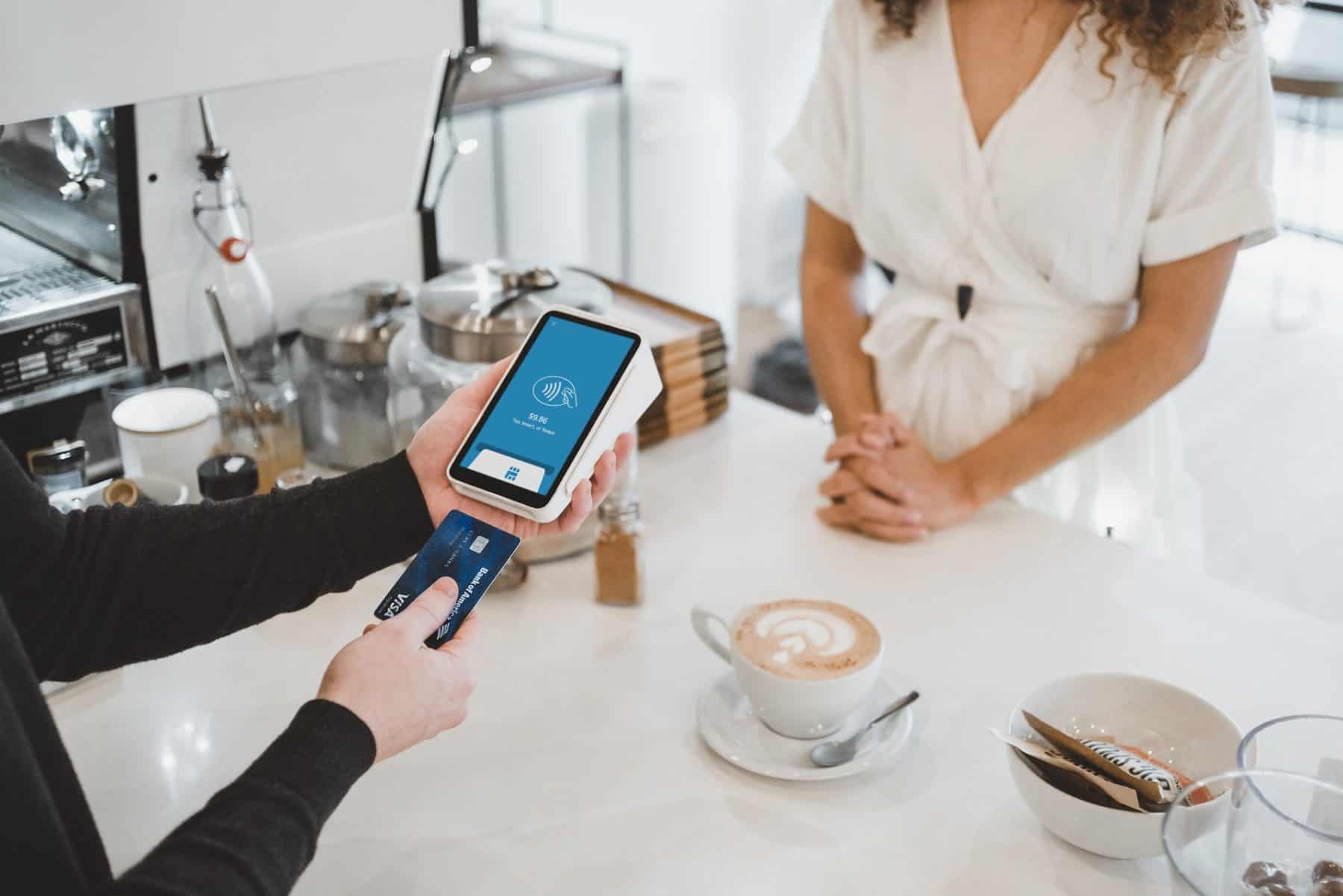
Contactless payment (or tap-to-pay) is popular in the Netherlands, and no PIN is needed for payments below €100. Above that, you will have to use your PIN code.
Read about PIN and contactless payment and Google Pay/Apple Pay rules as they may change over time.
While not having to carry cash around keeps things simple and safe, we are advocates of having a bit of cash handy.
You might like to buy small items, a snack at a food stand, or a very small shop that won't accept credit or debit cards.
Read below at the bottom of the post what travelers from our Amsterdam Travel Tips Facebook Group have to say on the subject.
Exchange Rates for the Euro
Should you choose to exchange some of your home country's currency for euros, here are some things to know.
Some common conversions into euros are from the U.S. dollar (USD), the Canadian dollar (CAD), the British pound (GBP), and the Australian dollar (AUD).
As of early January 2024, these were the exchange rates apply for these currencies:
- $1 USD is equal to around €0.90 and $100 is equal to roughly €90.50
- £1 GBP is equal to about €1.15 and £100 is equal to approximately around €115.43
- $1 CAD is equal to around €0.68 and $100 is equal to about €68.39
- $1 AUD is equal to around €0.61 and $100 is equal to about €61.69
Remember that exchange rates change daily as they are related to international financial market conditions.
Before you arrive in Amsterdam, Netherlands, become familiar with the standard exchange rate worldwide by looking at this currency converter website, xe.com .
Exchanging Your Currency
If you are traveling between EU countries that use the euro, your money situation will be quite simple to navigate.
But if you’re coming from another part of the world that does not use the euro, you may need to exchange some currency.
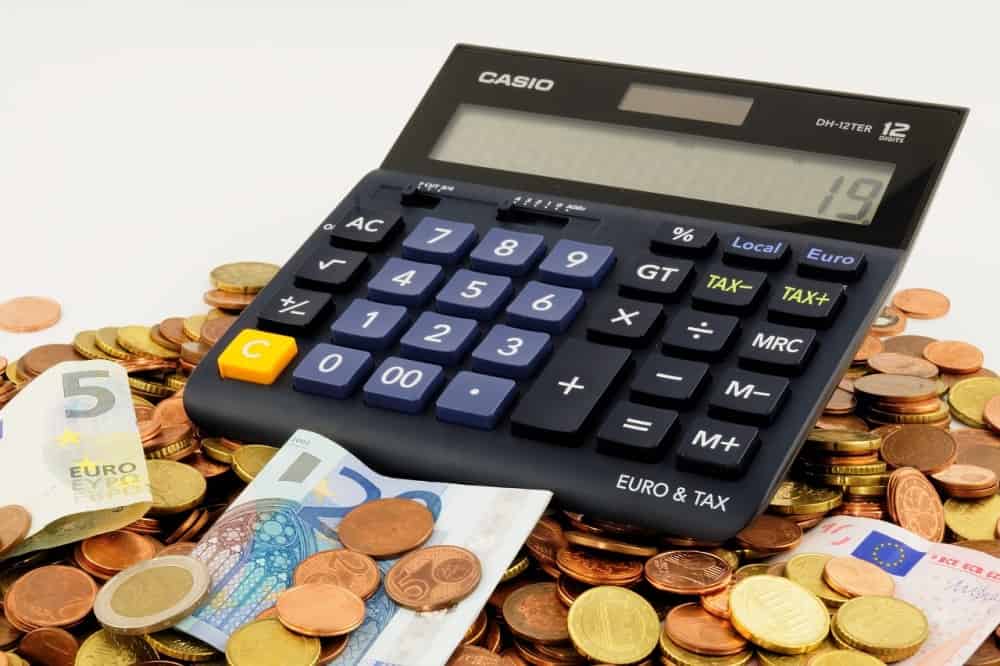
Avoid exchanging currency at Schiphol Airport . The rates offered will be considerably less favorable than at other exchange services.
Plus, you will likely pay a service fee cutting into the amount of euros you will receive in exchange for your currency.
Similarly, rates will not be as good if you exchange from hotels, shops, or currency kiosks.
If you do choose to use a currency exchange service, a popular and reliable one is Pott Change located at Damrak 95 near Dam Square , just minutes away from Amsterdam Central Station .
Withdrawing Cash From ATMs in Amsterdam
The most convenient way to get euros is by withdrawing them from ATMs ( geldautomaten) .
We prefer using the ATMs provided by the major banks as independent companies can charge higher fees.
These are ING, ABN AMRO, Rabobank, and SNS. Each has ATMs throughout the city.
They collaborate under one ATM system called Geldmaa t. The machines are bright yellow. Use this locator to find the nearest Geldmaa t ATM.
For more information on using one of these ATMs, read this helpful Geldmaat website .
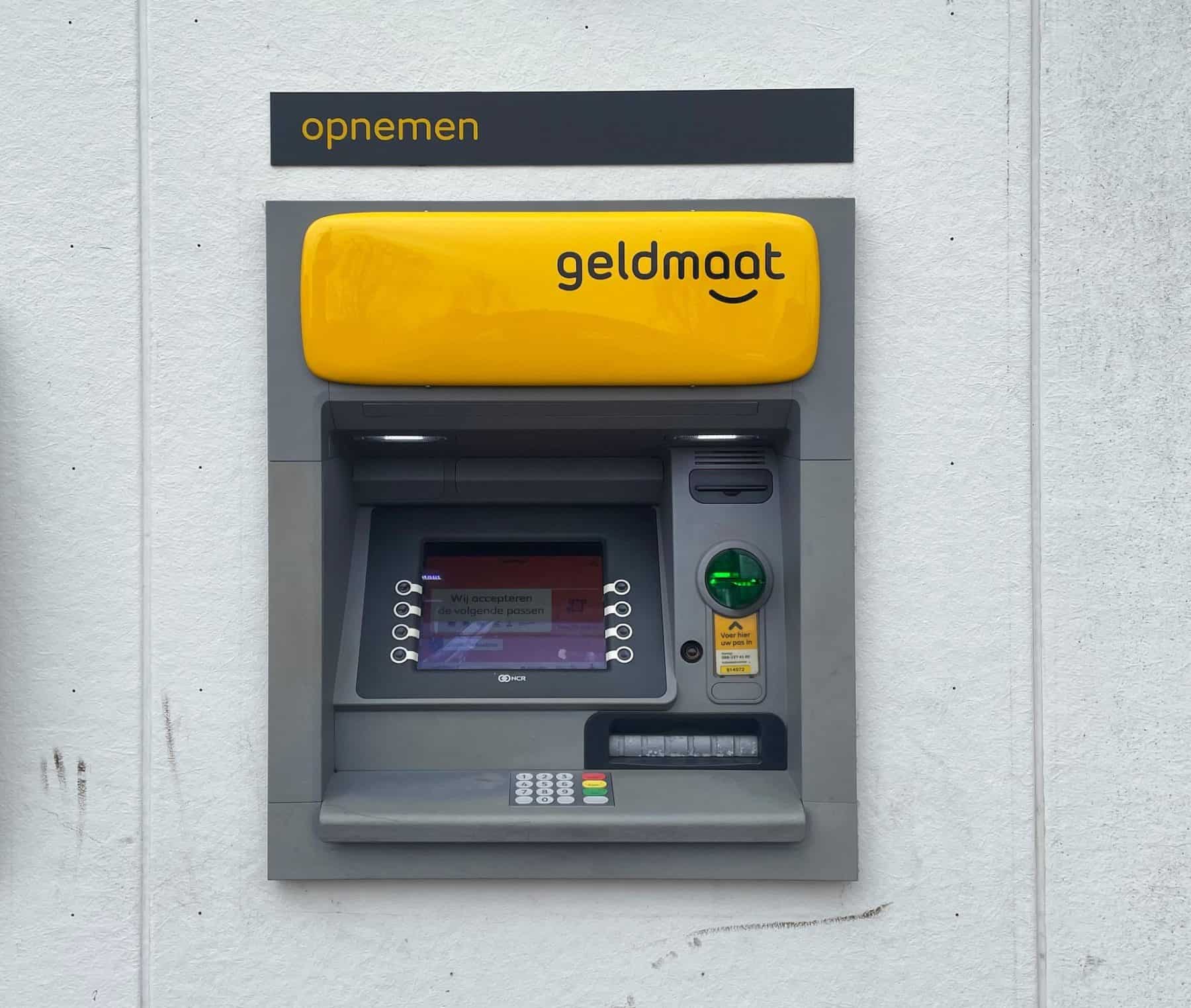
Good to know
- When given the option by the ATM what currency you want to receive your cash in, choose euros, not your home currency.
- All ATMs can dispense €50, €20, and €10 notes and some may have €5 notes.
- ATMs have a limit on the amount you can withdraw per transaction. At most machines, the amount is €2,000 per transaction.
- Most official bank-affiliated ATMs charge a €4 fee per transaction in addition to what your bank charges.
- It’s best to use your debit card at the ATM, and not a credit card as you will pay your credit card interest rate on that money.
- Many ATMs are not open overnight, closing at 23:00 (or earlier) and opening at 7:30. When you use the locator, check the hours of that ATM.
- Just as you would in your home country, exercise care when withdrawing cash, and take care to know who is around you.
REMINDER : Before you depart for your trip, let your bank and credit card companies know that you will be traveling overseas so they don't freeze your card when a foreign transaction pops up.
Currency Tips From Locals and Travelers
You don't have to rely on only us to tell you how to handle currency issues when there are loads of locals and tourists who also have first-hand knowledge.
Here are a few bits of advice from Amsterdam natives and tourists who are members of our Amsterdam Travel Tips Facebook Group.
By far, the most frequent currency question that came up was "Will I need cash?"
Here are many answers on the subject.
These two travelers and one local said that cash wasn't really necessary.

Travelers Eric and John made a good point about the need to get cash at an ATM only when you need some, and not bother bringing cash in advance.

Planning on going to Amsterdam in the winter ? Here’s some money advice for shopping, especially at the fabulous Christmas markets!

For more helpful advice, check out our Amsterdam Travel Tips Group on Facebook. You can post your questions there and you will get plenty of replies with different perspectives!
Related Posts
- Free Walking Tours in Amsterdam
- Things to Do in Amsterdam on a First Visit
- Which Amsterdam City Passes Are Best?
Choose a Destination... I want them all PLUS general travel tips. Amsterdam Berlin Boston Charleston Chicago Dubai Lisbon London Los Angeles Miami Nashville New York City New Orleans Paris Philadelphia Prague Rome San Francisco Washington DC
About The Author

Courtney Shapiro
North america, united kingdom & ireland, middle east & india, asia & oceania.

Check rates for our recommended hotels
- Book Hotels
Subscribe to our weekly newsletter
Subscribe and get our free guide to "101 Ways to Save in Europe"
* indicates a required field
Your subscription request has been received
Sorry, an error occurred and your subscription request could not be processed. Please try again later.
- See All Cities
- Advertising Info
- Customer Support
Amsterdam on a Budget: 10 simple ways to save on your trip
Feb 18, 2023
Audrey Sykes

Amsterdam isn’t the most expensive city in Europe (we’re looking at you London !), but it’s certainly not the cheapest. When visiting Amsterdam, you can expect to pay a little bit more for all of the essentials than you would in a place like Italy or Spain.
Luckily, with a little bit of planning and know-how, a visitor can easily keep to a budget in Amsterdam.
Amsterdam on a budget: 10 simple ways to save
Here are 10 ways to make that happen:
1. Avoid taxis if you can
Amsterdam is small and walkable, and public transport covers all areas of the city. A cab ride that costs you €20 to Museum Square is a quick and cheap €2.80 on the tram.
Please note: The city is not car-friendly , so time is rarely saved when cabbing it. If you must take a taxi, you can also try a private cab company like Uber. But a better solution is to go like a local and hop on a bike .

Wheels of Dutch cheese at the Saturday farmer’s market on Noordermarkt. Free samples are available! Photo: Craig Nelson
2. Shop the markets before the stores
This applies to food, clothes, trinkets, souvenirs, books and even wine. Waterlooplein’s flea market is open daily (except on Sundays) until 5 PM, while Nieuwmarkt and Noorderkerk have weekend markets with organic and locally grown produce and natural food products.
Mondays at Noorderkerk hold a vintage clothing market, while the Dappermarkt and Albert Cuypmarkt sell food, flowers, fresh fish stands, clothes, souvenirs and more. The flower market, however, is tourist priced. Here’s a list of our favorite outdoor markets in Amsterdam .
Related: 5 cheapo souvenir ideas to bring home from Amsterdam
3. Get an unlimited ticket for the trams
Instead of buying your tram tickets one by one at €2.80 each ride, think about an option that gives you unlimited access over one, two, three or seven days . The rates are quite reasonable:
- One day ticket: €18
- Two day: €24
- Three day: €30
Not only will you save money, but it’s just easier to hop on and off with this type of ticket. Tickets can be purchased sometimes on the tram itself, but try to buy at the metro area under Amsterdam Central Station if you can. (You can also purchase them online through the official transportation website .)
4. Think before paying for audio guides at museums
Now, we do love audioguides, so nobody take offense here. But at most museums in Amsterdam, many (if not most) descriptions of artwork and artist biographies are posted in both Dutch and English. Most likely the free info pamphlets will also be in Dutch and English.
So before reaching for an audio guide that costs extra, make sure it’s worth it — or that you’re really into the subject . We think the Van Gogh museum’s audioguide is worth a splurge, but think twice with Rijksmuseum and Anne Frank House , as you might be fine without it.
5. Skip the hotel breakfast and head to a bakery
Amsterdammers aren’t big on breakfast. Brunch on the weekends has recently caught on, but the usual morning starts with a simple combination of a baked good paired with fresh orange juice or coffee. The city is stocked with bakeries on every corner, selling whole-grain croissants, freshly baked bread rolls and cheese-filled pastries. It’s a cheaper option than any café that serves a typical American-style breakfast, and it might just be a tastier option as well.
It’s also probably a more affordable option that what’s being served at your hotel. As we mention in our Amsterdam hotel guide , ask when checking into your hotel about the breakfast menu. Before committing to pay for it, know what’s being served. A nearby bakery is probably a better deal.
6. Buy water at grocery stores
All that walking (and maybe biking!) is going to work up a thirst. With a lack of drinking fountains and free tap water, you should try to always buy your daily water at the nearest grocery store.
A normal bottle of water will cost about €2.50 at a snack stand or kiosk in the center of town. And you’ll see tourists lined up to buy them. However, at a grocery store, that same bottle will cost less than a euro —even for the fanciest mineral water. In fact, you’ll be able to buy an entire liter for less than a euro.
It might sound small, but the savings can really add up over the course of a week.

Bicycle Hotel in De Pijp neighborhood offers rooms starting at $50. Photo: EuroCheapo
7. For cheaper hotels, think outside the center
Hotels outside the city center are usually newer, renovated and slightly larger than hotels in the Red Light District and around Dam Square. Although you can find some good deals in the center , venturing to neighborhoods like De Pijp , Plantagebuurt , or Jordaan will offer refreshing alternatives not that far from the big attractions.
And plus, if you purchase an unlimited tram ticket (see above), you’ll still be able to explore the city to your heart’s content. See all of our recommended hotels in Amsterdam here and read out round up of our 10 favorite budget hotels in Amsterdam .
8. Avoid the Argentinian steakhouses
You’ll see them all over town, but there is really nothing Dutch or cultural about them. Argentinean steakhouses are just here for tourists. Most offer daily specials of steak and fries for about €20. Not too costly, but if you’re looking to spend your dime on quality food, try something else and use these tips to save when dining out .
9. Opt for beer and wine at the bar
If drinks are on the nightlife agenda, stick to beer and wine. Cocktails, mixed drinks, and anything bubbly is going to cost you. The alternatives are more impressive and half the price: house wine is usually something tasty from France or Spain, while the brews can be a classic pils or even a strong Belgian beer. Here’s a list of our favorite bars for beer .
Related: Navigating the exciting Amsterdam nightlife scene on a budget
10. Quantity over quality for bike rentals
To blend in like a local, hop on a bike to see the city . Timewise, it’s always cheaper to rent a bike for a long period of time, compared to just a few hours. Since bicycles are the main mode of transport in Amsterdam, it’s the most useful way to get around for natives and visitors alike. And rentals encourage this via their prices: a one-day rental could be anywhere from €7.50 to €15, but a three-day rental could be also €15.
Here are a few rental agencies that offer the cheapest prices in town.
More ways to visit Amsterdam on a Budget
Be sure to check out more of our articles about ways to save on your trip to Amsterdam here .
Search Hotels in Amsterdam
About the author.
About the author: Audrey Sykes hopped across the pond from the US eight years ago for a Masters degree in global journalism. Since then, she’s lived all over Europe, reporting and editing for music sites, snowboard mags, and travel media. She’s also the Amsterdam author for Party Earth , a guide to nightlife across Europe.
Related Posts
- Amsterdam Hotel Advice: Read this first
- Weekend in Amsterdam: The perfect first trip for budget travelers
- Best budget hotels in Amsterdam for 2024
- Amsterdam: 10 tips for dining on a budget
Leave a Reply Cancel reply
Your email address will not be published. Required fields are marked *
Notify me of follow-up comments by email.
Notify me of new posts by email.
7 thoughts on “Amsterdam on a Budget: 10 simple ways to save on your trip”
Tired of eating out? Try stocking up at the neighboring Albert Hijn supermarket. Good selection of food (suggest ham and various cheeses), helpful clerks, and the store layout is makes sense. Preiswertig. You’ll be done in a snap. Carry it back to your hotel and feast.
Sorry, but these are the worst tips I have every read. I mean, of course taxis are more expensive then the public transportation (actually this is the same in any kind of western european city). And water is cheaper in the Supermarket?! Really – what a tip.
Sorry but I was looking for real insider tips!
But by the way: Most of the time shared hostel rooms are cheaper then Single or double rooms in an expensive Hotel. But don´t tell anyone. 😉
Bakery a save bet for breakfast. Do they have table for dine in since you said it was cheap and more choice. Love the pastries and a coffee.
Regards…
They organise guided bike tours at the windmill park Zaanse Schans and around very close Amsterdam! http://www.zaanseschans-tours.com
Having had the opportunity to spent time in Amsterdam a number of times I have to say I agree with all but one of your suggestions. Unless you are a very experienced cyclist comfortable with riding in a commuter bicycle environment skip the temptation to try it in Amsterdam (or other European cities) where it is a common commuter activity. They ride fast and have a lot of experience… and are perhaps a little intolerant of those learning the necessary skills.

Great point! When I’ve been there, it’s almost like a thrill ride. You hop in the bike lane and away you go. No time to sightsee and meander along the path. You also have to be careful as a pedestrian to keep an eye out for bikes at all times. Thanks for chiming in.
THANK YOU !! I like your blog. You do write “who and what to avoid” while most others don’t. Keep it up !! I like the cheap Chinese buffets in Spain. Looking forward to how to eat cheap in Scandinavia.
Book Your Trip
Search our blog:, destinations.
- Aix-en-Provence
- – Free Paris
- – Paris Eating and Drinking
- – Paris Hotels
- – Paris Nightlife
- – Paris Outdoors
- – Paris Performance and Events
- – Paris Planning
- – Paris Shopping
- – Paris Sights
- – Paris Transportation
- Northern Ireland
- – Florence Eating and Drinking
- – Florence Practical Info
- – Florence Sightseeing
- – Rome Eating and Drinking
- – Rome Hotels
- – Rome Practical Info
- – Rome Sights
- – Venice Eating and Drinking
- – Venice Hotels
- – Venice Practical Info
- – Amsterdam Sights
- – Barcelona eating
- – Barcelona hotel advice
- – Barcelona planning
- – Barcelona sightseeing
- – London eating
- – London hotel advice
- – London neighborhoods
- – London sightseeing
- – London transportation
- – Brooklyn
- – New York hotel advice
- – New York neighborhoods
- – New York planning
- – New York sightseeing
Read more about: Planning for Amsterdam

Find us on Facebook
About eurocheapo.
Since 2001, our mission has been to make your time in Europe affordable and memorable. The world is out there, and it’s less expensive than you think.
© 2024 by Over There Interactive, Inc. All Rights Reserved. Privacy Policy
EuroCheapo Cities

The 5 Best Money Changers in Amsterdam
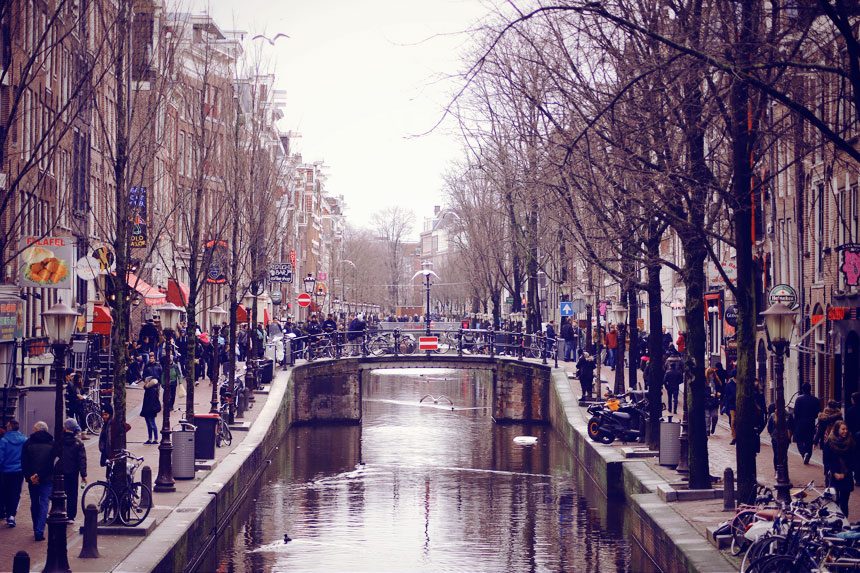
Like the way it is in Rome, Milan and Barcelona, withdrawing money at ATMs is the best way to get you more euros while being in Amsterdam. It is simply because the exchange rates one gets through ATM service are better than those offered at money exchange offices.
Although you have to pay bank fees for international transactions, the final amounts you get are still a better deal.
If you prefer bringing cash along to withdrawing local currency at ATM machines (locally called Geldautomaat ), then you need to find good money changers at convenient locations to add more Euros to your wallet.
We have done it for you. Before checking out the list of recommended forex shops in Amsterdam, take a couple of seconds to scan through a few worth-mentioning notes :
– The majority of Netherlands banks do not offer money exchange service to non-customers.
– Most banks do not accept traveler’s cheques , so exchange them at change offices such as Pott Change, Sunro Change, and GWK Travelex.
– Damrak avenue is the place to head to if you need access to a large number of reliable money changers in Amsterdam.
– Amsterdam’s change offices are available in forms of both established global currency exchange chains and individual money changers .
Now you are free to hunt for your right forex shops. See them below.
1. Pott Change
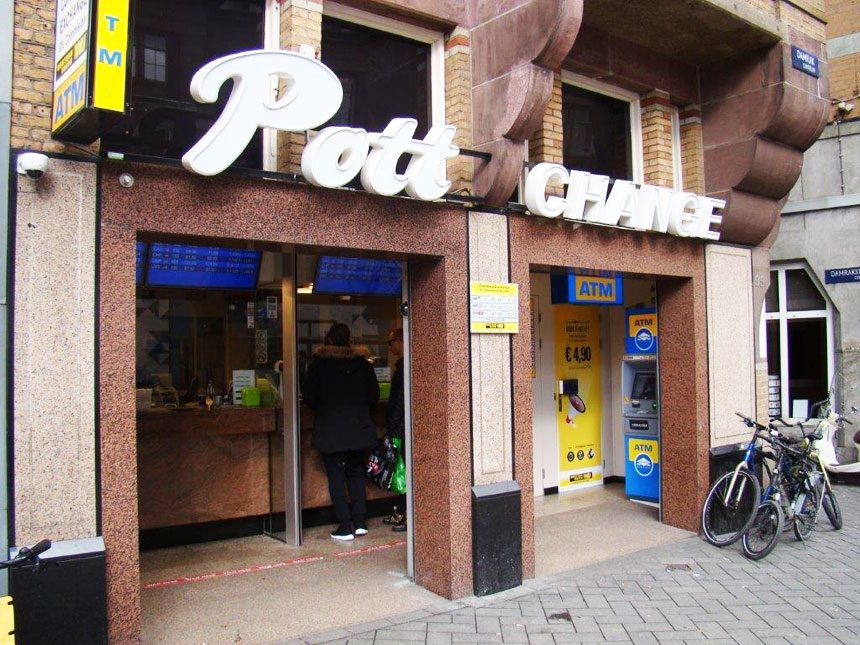
The first change office to check out on Damrak avenue must be Pott Change, the most popular independent money changer in Amsterdam.
This 25-year experience business has only one office in the capital of Netherlands. You can easily locate its shop, which is near the Royal Palace, the Nieuwe Kerk, and the National Monument.
Pott Change has won people’s hearts through constantly providing best rates alongside fast and efficient service. It also partners with Western Union to include worldwide money transfer service in its business.
Best rates for – USD – GBP – JPY – AUD – CAD – CHF – CZK – DKK – NOK – SEK
Branch information – Address: Damrak 95, 1012 LP Amsterdam, Netherlands – Phone: +31 20 626 3658 – Opening hours: Mon to Fri 08:30 – 20:15; Sat & Sun 09:30 – 20:15 – To check their exchange rates, click here
2. GWK Travelex
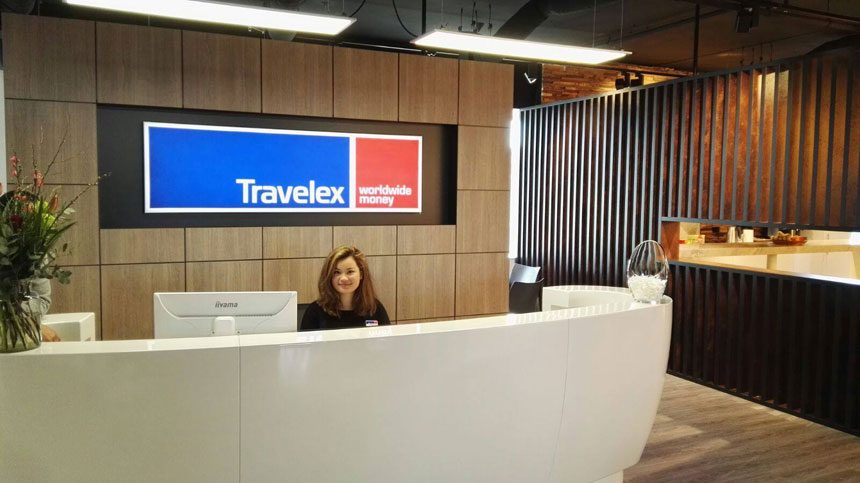
GWK Travelex is the result of the marriage of GWK, a Netherlands long history forex business, and Travelex in 2004.
GWK Travelex is a good choice for those who are looking for a reliable and well-established money exchange company in Amsterdam. Its 7 branches are all located in easily accessible commercial and tourist areas.
Traveler’s cheques are accepted at all of its branches. You can check their daily rates here .
Best rates for – INR – BRL – KRW – KWD – USD – PHP – SGD – AUD – OMR – QAR
Recommended branches 1. GWK Travelex @ Damrak – This branch is located beside KFC, just a short walk from the National Monument and the Royal Palace – Address: Damrak 86, 1012 LP Amsterdam, Netherlands – Phone: +31 20 624 6682 – Opening hours: Monday to Saturday 09:00 – 20:00; Sunday 11:00 – 18:00
2. GWK Travelex @ Kalverstraat – It is about a minute away from Arti et Amicitiae art gallery – Address: Kalverstraat 150, 1012 XD Amsterdam, Netherlands – Phone: +31 20 627 8087 – Opening hours: Sun & Mon 11:00 – 18:00; Tue, Wed, Fri & Sat 10:00 – 18:00; Thu 10:00 – 20:00
3. GWK Travelex @ Central Station – This branch is right inside Amsterdam Central Station terminal, near the waterfront – Address: IJhal, Amsterdam Centraal, Stationsplein 13F, 1012 AB Amsterdam, Netherlands – Phone: +31 20 627 2731 – Opening hours: Monday to Saturday 07:00 – 23:00; Sunday 08:00 – 23:00
4. GWK Travelex @ Leidsestraat – It is just a 1 minute walk from Leidseplein station and about 2 minutes away from Stadsschouwburg Theatre and Toneelgroep Theater – Address: Leidsestraat 103, 1017 NZ Amsterdam, Netherlands – Phone: +31 20 622 1425 – Opening hours: Monday to Friday 09:00 – 21:00; Saturday & Sunday 10:00 – 21:00
5. GWK Travelex @ Amstel – This branch is situated at Amstel Station, near the taxi stand – Address: NS Station Amsterdam Amstel, Julianaplein 1, 1097 DN Amsterdam, Netherlands – Phone: +31 20 693 4545 – Opening hours: Monday to Friday 09:00 – 19:00; Saturday & Sunday 10:00 – 17:00
3. Suri Change
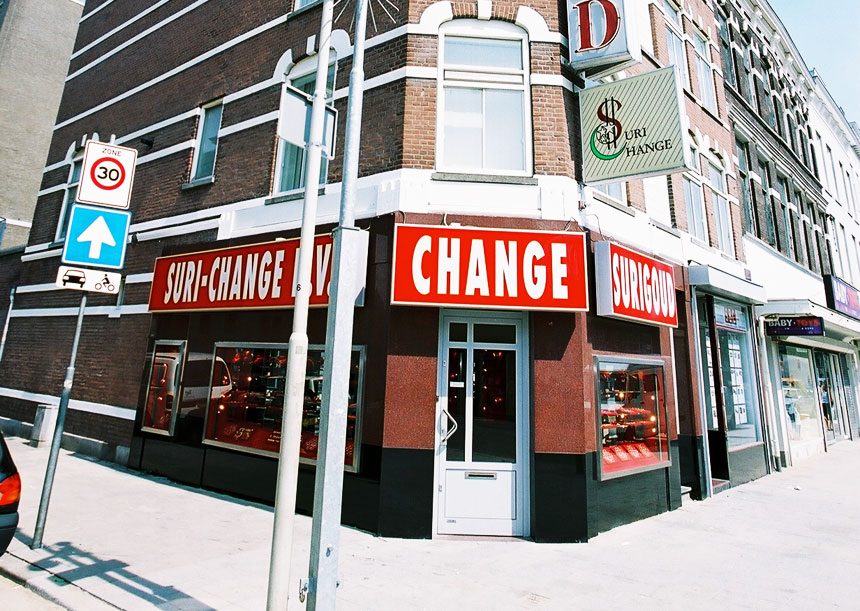
Suri Change was born in 1990 with a mission to take over the foreign exchange part that was a main business, alongside jewelry trading, of Suri Gold. Since then, the company has gained trust through giving people good service in foreign exchange and money transfer.
This Rotterdam- based money changer has 6 branches in Amsterdam. Two of them are located on Damrak avenue in Central Amsterdam. The other four have their homes in commercial areas in the outer boroughs of the city.
Best rates for – SRD – MAD – COP – PHP – IDR – DOP
Branches 1. Suri Change @ Damrak 45 – This branch is located across Beurs van Berlage – Address: Damrak 45, 1012 LK Amsterdam, Netherlands – Phone: +31 10 411 1707/+31 088 0082777 – Opening hours: Monday to Saturday 11:00 – 20:00; Sunday 12:00 – 20:00
2. Suri Change @ Damrak 31 – It is just a short walk from Beurs van Berlage – Address: Damrak 31, 1012LJ Amsterdam, Netherlands – Phone: +31 088 0082777 – Opening hours: Monday to Saturday 10:00 – 23:00; Sunday 12:00 – 23:00
3. Suri Change @ Amsterdam East – This branch has its location at the Dappermarkt – Address: Eerste van Swindenstraat 28, 1093 Amsterdam, Netherlands – Phone: +31 10 411 1707/+31 088 0082777 – Opening hours: Monday to Friday 09:00 – 18:00; Saturday 09:00 – 17:00
4. Suri Change @ Amsterdam West – Its location is between Mercatorplein and Marco Polostraat LRT stations – Address: Jan Evertsenstraat 102, 1056 EH Amsterdam, Netherlands – Phone: +31 10 414 9553/+31 088 0082777 – Opening hours: Monday to Friday 09:00 – 18:00; Saturday 09:00 – 17:00
5. Suri Change @ Bijlmerplein – This branch is within walking distance from Amsterdam Arena and Biljmer Park Theater – Address: Bijlmerplein 205, 1102 DD Amsterdam-Zuidoost, Netherlands – Phone: +31 10 414 9553/+31 088 0082777 – Opening hours: Monday to Wednesday, Friday 09:00 – 18:00; Thursday 09:00 – 20:00; Saturday 09:00 – 17:00
4. Lorentz Change
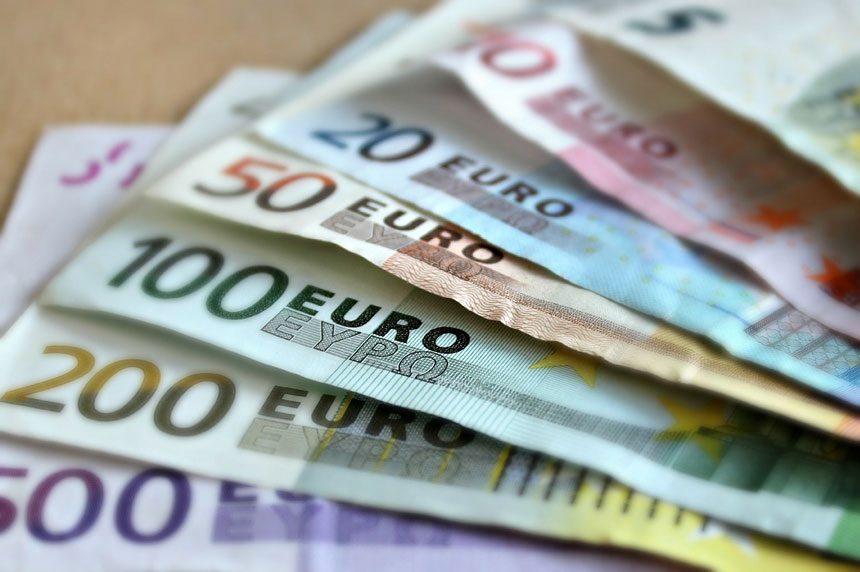
Lorentz Change with its competitive rates is among the favorite choices of travelers. It is an independent money changer that operates 3 branches in Amsterdam. They all are conveniently located at popular tourist areas and open 7 day a week.
Branches 1. Lorentz Change @ Damrak – This branch is located beside Intertoys, just a short walk from Beurs van Berlag – Address: Damrak 31, 1012 LJ Amsterdam, Netherlands – Phone: +31 20 420 6002 – Opening hours: Daily 08:30 – 23:30
2. Lorentz Change @ Damstraat – Its location is beside Parfumerie Marjo, near Oude Dolenstraat Bridge – Address: Damstraat 31, 1012 JL Amsterdam, Netherlands – Phone: +31 20 422 8841 – Opening hours: Friday to Wednesday 10:30 – 19:30; Thursday 11:30 – 19:30
3. Lorentz Change @ Damstraat – It is just a short walk from Leidseplein Station, Stadsschouwburg Theatre and Toneelgroep Theatre – Address: Leidsestraat 102, 1017 PG Amsterdam, Netherlands – Phone: +31 20 427 2164 – Opening hours: Daily 09:00 – 22:00
5. Sunro Change
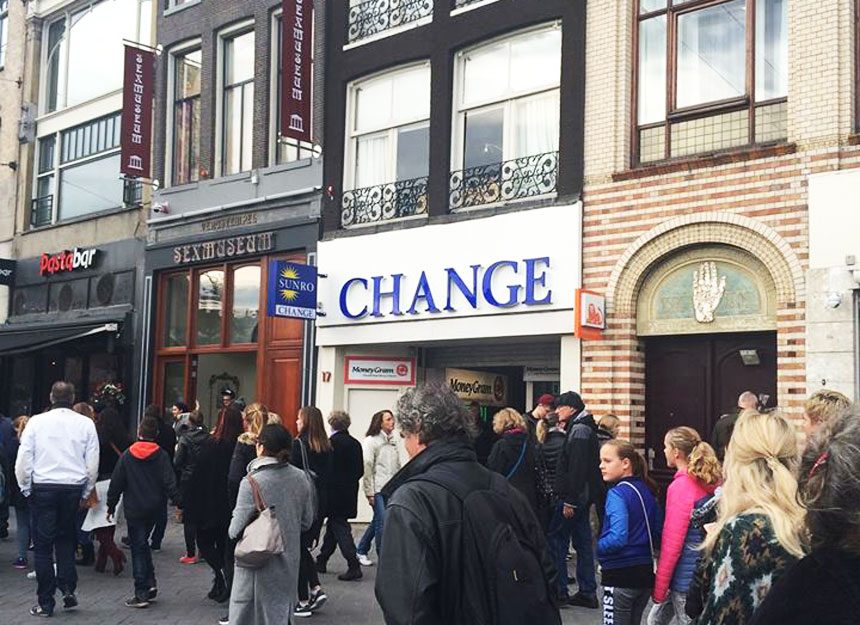
Sunro Change is a foreign exchange company that also offers remittance service. It accepts 30 currencies as well as traveler’s cheques. The company currently operates only one branch in Amsterdam.
Its Amsterdam branch is hard to miss because it is located right beside the famous Sex Museum on Damrak. So, if you are curious enough to see the display in the museum, you can swing by and exchange your cash at Sunro Change.
Branch information – Address: Damrak 17 II, 1012 LH Amsterdam, Netherlands – Phone: +31 20 626 5156 – Opening hours: Daily 08:15 – 21:30
You May Also Like

33 Amsterdam Travel Tips – All the Tricks You Need to Know
- Post author: Naddya
- Post category: City Travel
- Post published: September 2, 2020

Are you looking for the best tricks and hacks for navigating the quirky Dutch capital as an independent traveler?
If you love exploring multicultural cities with vibrant traditions, this article with 33 Amsterdam travel tips will help you enjoy the city on canals in the best way possible.
From the gear you should bring to the transportation you could use, and from the money-saving tips to the best neighborhoods to stay in, here is our best battle-tested advice.
Use the navigation below for easy browsing.
Ready? Let’s dive right in.
Note : This article contains affiliate links . In case you purchase something through one of these links, we may receive a small commission at no extra cost for you. Thank you for helping us keep creating the free content on this website!

Preparation – Things to Do Before You Go to Amsterdam
The first section of our travel guide is all about the things to know before traveling to Amsterdam .
- Do you need a visa to travel to Amsterdam? The Netherlands is a member of the European Union and the Schengen Area . If you possess a U.S. passport with at least 6 months validity, you can explore the country for up to 90 days without a visa. Find the complete list of visa requirements on the European Union’s official website .
- Dutch is the official language of the Netherlands . However, in Amsterdam virtually everybody speaks English. Want to impress the locals or show respect to their language? We’ve prepared 5 common phrases for you:

- Bring your best rain gear. Rain features in several of our Amsterdam travel tips. But there’s a good reason for this. On average, it rains 133 days per year in Amsterdam. Don’t let a little bit of rainfall spoil your day in Amsterdam by not dressing up properly. And if you’re wondering what else to pack, grab our handy Travel Checklist and never wonder again.
- Is Amsterdam safe to visit? Often, travelers consider big cities to be more dangerous than smaller towns. And when they hear that drugs and sex are (kind of) legal in Amsterdam, the notion is that it must be dangerous. On the contrary. Except for pickpockets – the plague of every place frequented by tourists – Amsterdam is indeed one of the safest places to travel to. In fact, at Number 4, it’s the highest-ranked European city in The Economist’s Safe Cities Report for 2019. Still, two things you mustn’t do: 1) don’t photograph in the red-light districts, and 2) don’t buy and/or consume drugs in the streets of Amsterdam.
- Cyclists are everywhere in the Dutch capital. In order to comprehend this Amsterdam travel tip fully, keep in mind that there are more bicycles than there are residents of the Dutch capital. Don’t walk in the bike lanes and always look twice before crossing the street.
- Book your tickets in advance. Especially in high season, waiting to enter any of the museums and galleries in Amsterdam can eat up most of your precious travel time. Skip-the-line tickets are your best friend if you want to optimize your experience.

Weather – When Is the Best Time to Visit Amsterdam
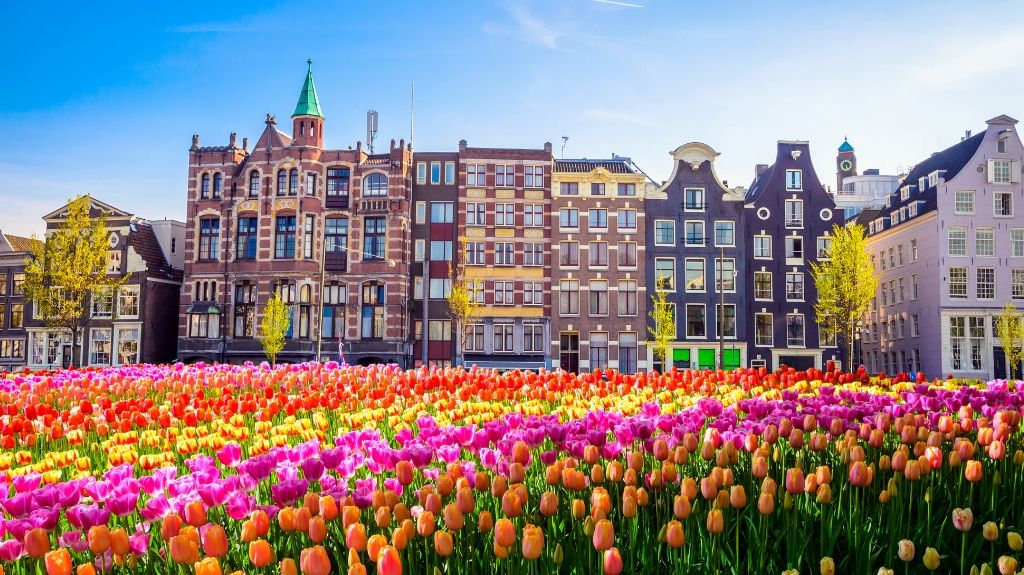
It would be best to explore Amsterdam (or any other city) when the sun is shining but not burning.
However, approximately 30% more precipitation falls here than over “rainy” London .
Still, let’s find out when exactly it’s best to travel to Amsterdam .
- It rains often in Amsterdam. We mentioned this travel tip earlier, but we can’t stress it enough. The oceanic climate , influenced by the North Sea, is the main reason for the intense rainfall. However, with the multitudes of museums, galleries, and shops, you’ll have plenty of fun things to do even if it’s pouring outside.
- Spring is drier than the rest of the year in Amsterdam. In April, you’ll have less chance of rain than in other months. Also, on April 27 th – the King’s Day – all of Amsterdam dresses in orange, the Dutch royal color. Moreover, in April and May is the tulips’ blossoming time! The best place to see them is Keukenhof Park just 25 mi (40 km) away from the capital. You won’t want to miss these colorful explosions.
Note : Don’t buy tulip bulbs in spring. They will not grow! That’s one of the biggest tourist scams in Amsterdam. You should buy bulbs in autumn and plant them right away, but no seller will tell you that. In fact, Naddya and her friends bought tulip bulbs in May – needless to say, none of them grew.
- Summer in Amsterdam is not as scorching hot as in South European cities, like Barcelona , for example. Also, there’s a festival happening every weekend! Around 300 festivals take place in and around the Dutch capital. The majority of them happen in this season. In the summer months, you can chill out or have a picnic on one of the five city beaches or in the amazing parks in Amsterdam .
- Autumn is the rainiest season to visit Amsterdam. Which means fewer tourists. And with the numerous museums, (coffee) shops, concerts, and galleries around town, you won’t even notice the gloomy weather. Besides, every tree in the city explodes in a magical golden crown. Plus, as we mentioned above – you can stock up on bulbs for your home garden in autumn!
- Winters in the Dutch capital are barely snowy. On average, it snows on 26 days per year. In fact, there’s a bigger chance of rain than snow in this time of the year. Let this not discourage you from traveling in this season. The Amsterdam Light Festival enchants you between December and mid-January. Ice-skate rinks invite you to try your best pirouettes. Christmas Markets seduce you with fashion, music, and scrumptious treats for the whole family. We suggest you sip at least one cup of the aromatic mulled wine. It will keep you warm, lift your holiday spirit, and boost your energy.

Money-Saving Travel Tips: How to Stretch Your Bucks in Amsterdam
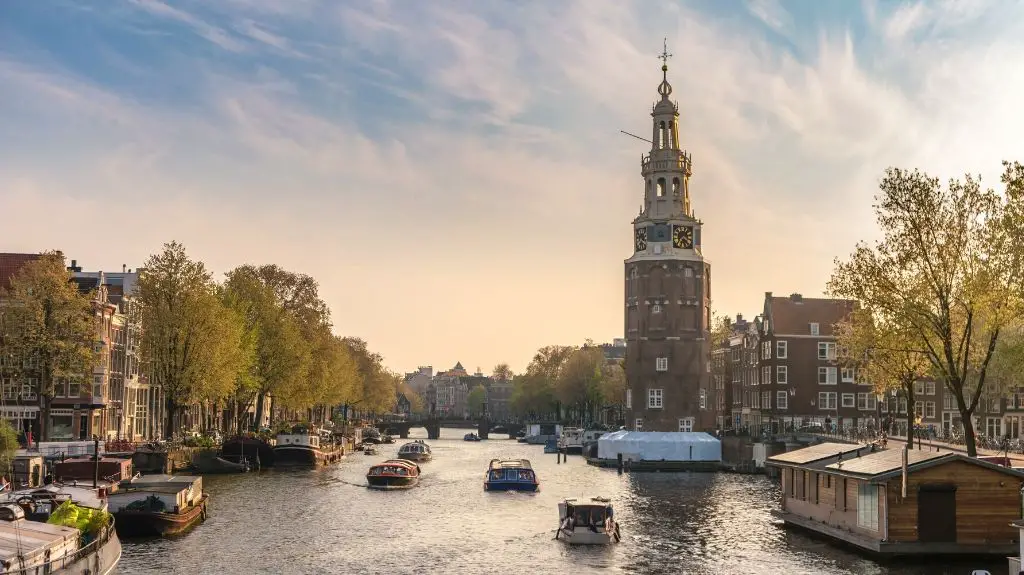
The following travel tips are about how to save money in Amsterdam . Even if you’re not traveling on a tight budget, we bet you wouldn’t mind stretching your bucks.
- Don’t park your car anywhere near the city center. That’s one of the best Amsterdam travel tips to save you money. If you arrive by car, leave it somewhere outside the center. Otherwise, you might end up paying more for your parking spot than for your accommodation.
- Amsterdam is very walkable. You can trot from one end to the other in about 45 minutes. Still, if you don’t want to use your feet everywhere , public transportation is affordable. Prices start from €3.20 ($3.75) for a single, 1-hour ticket. The day passes currently cost €8.00 ($9.40).
- It’s safe to drink the tap water in Amsterdam. If you don’t want to pay every time you get thirsty, we have some good news! You can drink directly from one of the 500+ public drinking fountains or fill up your bottle from the tap. Amsterdam’s water wasn’t always safe to drink. However, since 1903, the city’s authorities have made sure every resident has access to safe, drinkable water. (Read the next section of our Amsterdam travel tips to find out what was the solution to the unsafe drinking water back in the 17 th century!) Many restaurants will also serve you tap water for free, but just as many will only sell expensive bottled water.
- Do you tip in Amsterdam? We bet you’ve asked yourself if you need to leave 5, 10, or 15% on top of the bill. In our experience, people don’t expect you to leave a tip. If you’re happy with the service, you can round up the check and pay up to 10% more. However, your waiter will not give you a dirty look if you don’t.
- Pick the best-value canal cruise for your budget. Cruising through the Amsterdam canals is the best way to explore the city. The cheapest tickets at the time of writing this travel guide cost €12.50 ($14.70). Prices vary based on several conditions:
- Starting point of the canal cruise . We’ve discovered that boats leaving the port right outside the Amsterdam Centraal Station are more expensive than the ones from other starting locations. Naddya has hopped on a boat from Herengracht and paid less than her friends for the same cruise.
- Duration of the boat tour . The tours’ duration starts from 60 minutes and can go up to half a day. Also, there are 24- and 48-hour hop-on/hop-off boats .
- The type of the vessel . A tour in a tourist boat with a glass roof naturally costs less than an adventure in a historical wooden boat. It’s up to you to decide which one you prefer.
- What’s included in the ticket . Most of the cruises only include the tour itself and a multilingual narration from the captain. Others offer all-you-can-eat buffets or romantic dinners.
- You can do a ton of free or cheap activities in Amsterdam. Strolling the streets of the historic center and iconic neighborhoods is at no charge. Parks, markets, and churches are also free to explore. Amsterdam will also seduce you with free concerts and performances. Below are several ideas for not-so-obvious free activities and discount tips.
- Schuttersgalerij Amsterdam ( Civic Guards Gallery ). The collection, managed by the Amsterdam Museum , contains portraits of wealthy citizens and contemporary stars. There’s no admission fee to see the masterpieces, some of which are the works of Rembrandt or Hals . You’ll find the gallery at Kalverstraat 92 .
- Free ferries . Departing behind Amsterdam Centraal , you’ll find free connections across the River IJ (pronounced “ eye ”). The blue-and-white boats shuttle pedestrians, cyclists, and mopeds to different locations in Amsterdam Noord . The ferries are quick, easy, and free to use.
- Heineken Experience . By buying your ticket online, you’ll get a €3.00 ($3.50) discount.
- Microbreweries . You can buy a couple of craft beers and tour a microbrewery for the price of the Heineken Experience . For example, try a glass of Flink or Zatte , included in the ticket price for touring Brouwerij ‘t IJ .
- Invest in the IAMSTERDAM city card. If you’re staying in Amsterdam for a couple of days and plan to visit several museums, the card will easily pay itself off. You’ll get free admissions to 70+ museums and attractions, free public transportation, a canal cruise, and unlimited bike rentals. Prices start from €65.00 ($76.45) for the 24-hour pass and go all the way up to €130.00 ($152.90) for the 5-day card. We know it sounds like a lot, but museum tickets and tours add up quickly, so do your math before deciding. For example, at the time of writing, the entrance to the Rijksmuseum is €19.00 ($22.35). A visit to the Van Gogh Museum costs the same. The tickets to the Anne Frank House and the Rembrandt House are €12.50 ($14.70) and €14.00 ($16.45), respectively.

Food & Drinks in Amsterdam: What You Shouldn’t Miss Tasting
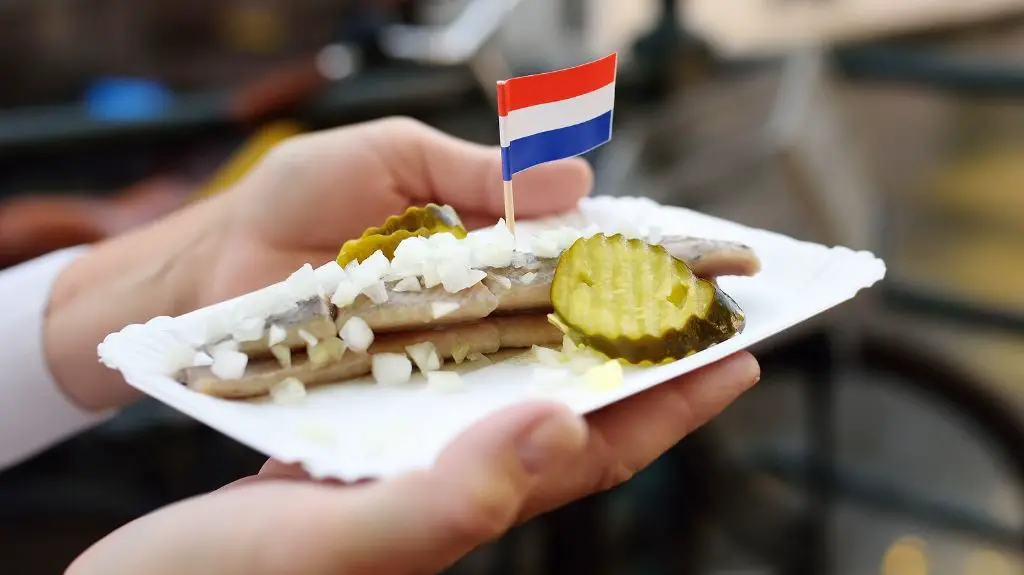
Even if you’ve never tried any Dutch dishes before, we bet you’ve at least had cheese and beer produced in the Netherlands. Find out what other foodgasms await you in Amsterdam.
- If you’re looking to try traditional Dutch foods, here are the most famous ones:
- Cheese . The Netherlands is the #1 cheese-exporting nation . No wonder – they’ve been making the dairy product for over 16 centuries. Edam, Gouda, Leyden , Maasdam , and Limburger are all Dutch.
- Patat . Locals call them also Friet , Vlaamse frieten , Fritjes , and eat them with different toppings – mayo, ketchup, curry, and minced onions. They’re also thicker than the normal French fries.
- Bitterballen . The fried meat balls are the perfect beer snack, along with Patat . You’ll find them in almost every pub or café.
- Kibbeling . Eat these deep-fried, battered chunks of fish with mayo-garlic or tartar sauce. Be sure to limit your portions, so you don’t get addicted to the tasty Dutch snack.
- Frikandel . This skinless, deep-fried sausage combines chicken, pork, and beef! You have multiple options for eating it: by itself, topped with mayo, in a roll ( Broodje frikandel ), or sliced and drowned in mayo, curry, ketchup, and chopped onions.
- Harring Hollandse Nieuwe . The Dutch New Herring is probably the most famous food in the Netherlands. It consists of raw herring, gherkins, and chopped onions.
- Stroopwafel . The Stroopwafel is the most popular Dutch pastry. The layers of baked batter are glued together by a mouth-watering syrup. You can buy the waffles in every supermarket and café.
- Amsterdam’s population consists of 180 nationalities, and this shows in the food scene. If you’re not interested in tasting Dutch dishes and want to save time, have a quick bite at an Asian restaurant , a kebab house , or a sandwich deli . We also recommend Indonesian and Surinamese eateries, if you’re up to trying ethnic food. And if you want to have a long, relaxed meal with several courses and multiple foodgasms, visit one of the 12 Michelin-starred restaurants in Amsterdam.
- If you don’t want to splurge on a restaurant meal, eat at one of the markets. Here are the marketplaces Amsterdam is famous for :
- Albert Cuypmarkt . The largest outdoor market in Europe has a huge selection of street food stalls and delicacies.
- Noordermarkt . Great place for grocery shopping and trying Dutch produce.
- IJ-Hallen . The biggest flea market in Europe doesn’t only offer second-hand items. It will also seduce you with a variety of street foods. Have in mind that there’s a €5.00 ($5.90) entrance fee.
- Amsterdam has been a major beer brewing center since the 16 th century. At that time – unlike nowadays – water was unsafe to drink. Along with the world-famous Heineken , another excellent local brand you should order is Amstel . If you’d like to taste something stronger, try the Trappist La Trappe .
- Heineken , founded in Amsterdam, is among the top 3 largest beer breweries in the world. Beer aficionados visit the Heineken Brewery for a few reasons:
- To taste fresh Heineken beer straight from the tap.
- To learn about the history of one of the world’s most famous beer brands.
- To stock up on handy souvenirs (just like Svet who has several glasses from the Heineken Experience shop).
- Learn the difference between a coffee shop, a koffiehuis , and a café. Coffee shops don’t serve coffee but sell cannabis and hash . Cafés are more similar to restaurants or bistros. A koffiehuis (literally coffee house from Dutch) is where you can get your caffeine kick in the Netherlands. We know, it’s complicated. That’s probably one of the craziest facts about Amsterdam .

Traveling in Amsterdam: Types of Transportation and Getting Around the City
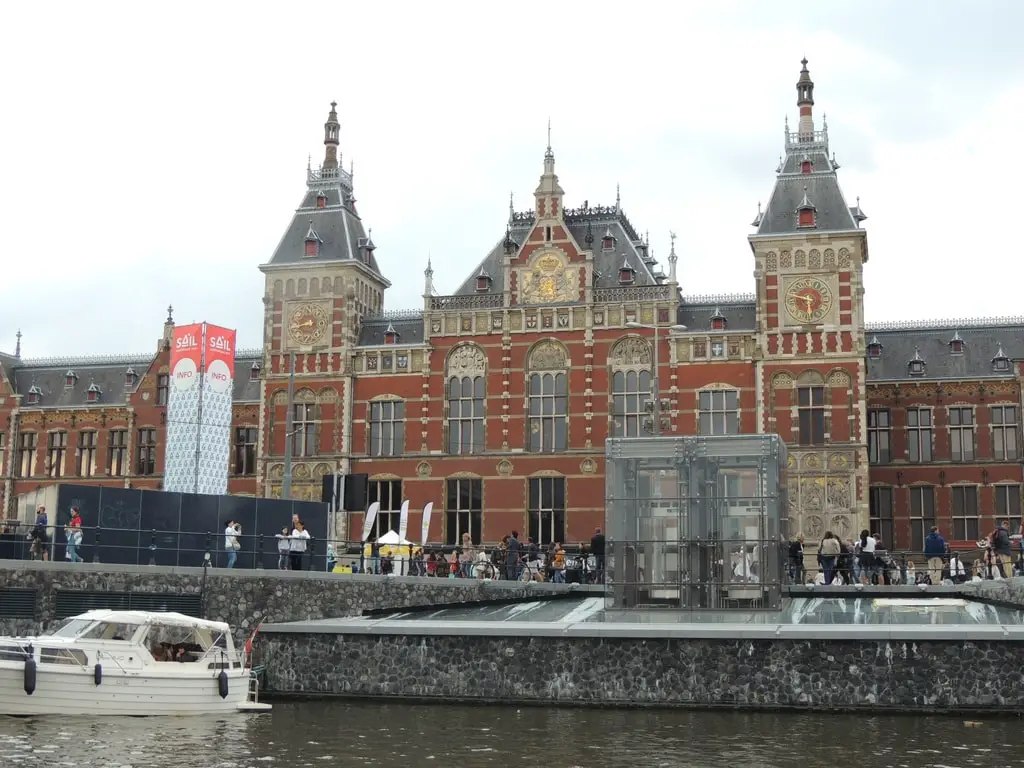
These Amsterdam travel tips about the different types of transportation in the Dutch capital are extremely important to follow. Why? Because the city has some unique travel modes which most of us are unfamiliar with. Let’s find out more.
- Getting from Schiphol to Amsterdam Centraal takes less than 20 minutes. The direct train stops in the heart of the city. From there, you can start sightseeing right away.
- The best way to explore the city is on foot. We always recommend this way of transportation, especially for walkable cities like Amsterdam. This means that you should wear a sturdy pair of shoes. The best travel tip we can give you here is to be extra careful when crossing the street. Always look twice and don’t stand or walk in the bike lanes (usually painted in red).
- The public transportation system is convenient and easy to navigate. It consists of trains, metro, trams, buses, and something else (read our next travel tip about that something ). You can buy your ticket in advance online, from a vending machine, or from the vehicle operator. Have in mind that you can’t pay in cash. Tickets are valid from one hour up to 7 days. If you’re staying longer in Amsterdam, consider purchasing a rechargeable chip card, the OV-Chipkaart . When using it, don’t forget to check-in/-out at the card readers when entering or leaving a vehicle.
- Use the free ferries to explore outside the city center. The blue-and-white boats shuttle pedestrians, cyclists, and mopeds to different locations in Amsterdam Noord . They depart behind Amsterdam Centraal and transport passengers across the River IJ. The ferries are quick, convenient, and free to use. Now, that’s not something you can do in a lot of places, right?
- Some of the canal cruises offer hop-on/hop-off boats. They stop at different tourist attractions, just like your usual hop-on/hop-off buses in other cities around the world.
- Another very Dutch way to explore Amsterdam is on a bicycle. Amsterdam is a city of bikes. The prices start from €3.00/1 hour ($3.50/1 hour). You can find daily rentals for as low as €10.00 ($11.75) for a normal bicycle and €17.00-€27.00 ($19.99-$31.75) for an e-bike. Be sure to obey the traffic rules and wear a helmet.
Note : As mentioned earlier, unlimited bike rentals are included with the IAMSTERDAM card for the duration of its validity.

Where to Stay in Amsterdam: Best Neighborhoods and Accommodations
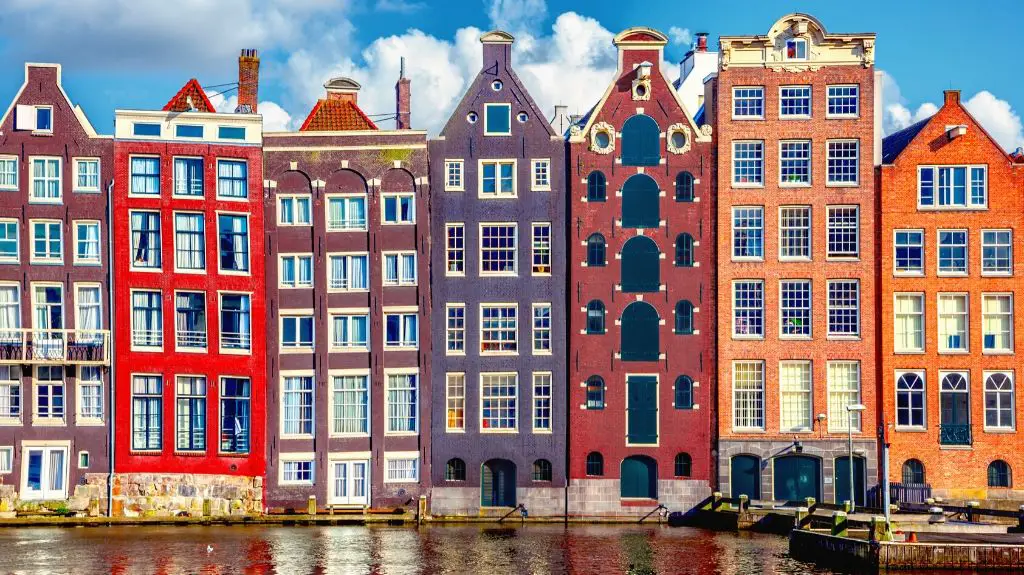
No travel guide would be complete without tips on how to save on accommodation and which are the best areas to stay in Amsterdam . So, below are our recommendations.
- The night rates are quite unpredictable. Of course, accommodations are cheaper in the low season. Like in most European destinations, you can expect to find lower prices between October and March, except around the holiday season. Some travelers also claim that rooms are cheaper during the week. The latter makes sense, having in mind that Amsterdam is a nightlife mecca, especially during the weekend.
- You can stay in some pretty unique accommodations in Amsterdam. From houses built in the 1600s to houseboats, the Dutch capital offers a variety of distinctive rooms. Don’t forget that these come with certain limitations. For example, older houses have steep staircases and no elevators. And on houseboats, you’ll feel every movement of the water around you. But if that doesn’t bother you, go find your unique Amsterdam accommodation!
- Unless you’re visiting Amsterdam for the nightlife, choose an accommodation far from Dam Square and De Wallen. Instead, opt-in for some of the quieter neighborhoods:
- Westerpark. The area is close to multiple attractions and at a walking distance from the heart of the Dutch capital. It also has its own park as the name suggests.
- Jordaan. Many travelers consider this the coolest and most romantic area to stay in while in Amsterdam. It’s closest to the city center than any of the other neighborhoods we recommend. Thus, it is the easiest to explore from here. You’ll also have plenty of choice for trendy bars, charming restaurants, and quirky shops.
- Amsterdam Oud-West. The “old west” part of Amsterdam – as the name translates – is separated from the city center only by Singelgracht . Yet, you won’t get much of the parties and nightlife noise. The multicultural area promises dining at exquisite bars and restaurants.
- Amsterdam Oud-Zuid. At the edge of the “old south” part of the city, you’ll find Rijksmuseum , Heineken Experience , and Albert Cuypmarkt . From there, any other attraction is also a short walk away. Choose this area if you’re traveling on a limited budget.
- Plantage. This residential area with Jewish heritage is a great place for families to stay in Amsterdam. The Artis Royal Zoo – one of the oldest zoos in Europe – is located here. A lot of the other attractions in the area are dedicated to the Jewish people and the Holocaust.
Which One is Your Favorite Amsterdam Travel Tip?
There you have it – all Amsterdam travel tips that you need for a memorable visit.
The city of canals and bicycles is a unique place to travel to. Unusual things to do in Amsterdam and quirky surprises lurk behind every corner.
In order to best prepare yourself for your trip, make sure you use these travel tricks and hacks.
Now, share with us:
When are you going there?
If you’ve already been to Amsterdam, what impressed you the most?

You Might Also Like

33 Interesting Facts About Vienna You Should Know

33 Fun Facts About Prague to Make You Fall in Love with It

33 Best Valencia Travel Tips: Visit the Birthplace of Paella
This post has 4 comments.
Thanks for sharing these tips! Amsterdam is known for its gorgeous canals. Perfect for a walk.
You’re welcome! 🙂 Absolutely agree, walking around Amsterdam’s canals is the best way to explore the Dutch capital.
Excellent tips. So excited for our first visit this April for 4 nights-this is invaluable info. Thank you so much for sharing!
Thanks, Jackie!
Amsterdam is an awesome destination, we’re sure you’ll have tons of fun 🙂
Check out the rest of our Amsterdam posts as well and let us know if we can help you with anything else.
Leave a Reply Cancel reply
Save my name, email, and website in this browser for the next time I comment.
- Argentina
- Australia
- Deutschland
- Magyarország
- Nederland
- New Zealand
- Österreich
- Singapore
- United Kingdom
- United States
- 繁體中文 (香港)
6 Best Travel Cards for Amsterdam
Getting an international travel card before you travel to Amsterdam can make it cheaper and more convenient when you spend in Euro. You'll be able to easily top up your card in USD before you leave the US, to convert seamlessly to EUR for secure and flexible spending and withdrawals.
This guide walks through our picks of the best travel cards available for anyone from the US heading to Amsterdam, like Wise or Revolut. We'll walk through a head to head comparison, and a detailed look at their features, benefits and drawbacks.

6 best travel money cards for Amsterdam:
Let's kick off our roundup of the best travel cards for Amsterdam with a head to head comparison on important features. Here's an overview of the providers we've picked to look at, for customers looking for ways to spend conveniently overseas when travelling from the US:
Each of the international travel cards we’ve picked out have their own features and fees, which may mean they suit different customer needs. Keep reading to learn more about the features, advantages and disadvantages of each - plus a look at how to order the travel card of your choice before you head off to Amsterdam.
Wise travel card
Open a Wise account online or in the Wise app, to order a Wise travel card you can use for convenient spending and withdrawals in Amsterdam. Wise accounts can hold 40+ currencies, so you can top up in USD easily from your bank or using your card. Whenever you travel, to Amsterdam or beyond, you’ll have the option to convert to the currency you need in advance if it’s supported for holding a balance, or simply let the card do the conversion at the point of payment.
In either case you’ll get the mid-market exchange rate with low, transparent fees whenever you spend in EUR, plus some free ATM withdrawals every month - perfect if you’re looking for easy ways to arrange your travel cash.
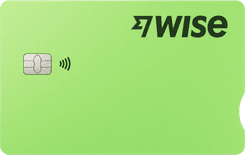
Wise features
Wise travel card pros and cons.
- Hold and exchange 40+ currencies with the mid-market rate
- Spend seamlessly in EUR when you travel
- Some free ATM withdrawals every month, for those times only cash will do
- Ways to receive payments to your Wise account conveniently
- Manage your account and card from your phone
- 9 USD delivery fee for your first card
- ATM fees apply once you've exhausted your monthly free withdrawals
- Physical cards may take 14 - 21 days to arrive
How to apply for a Wise card
Here’s how to apply for a Wise account and order a Wise travel card in the US:
Open the Wise app or desktop site
Select Register and confirm you want to open a personal account
Register with your email, Facebook, Apple or Google ID
Upload your ID document to complete the verification step
Tap the Cards tab to order your card
Pay the one time 9 USD fee, confirm your mailing address, and your card will be on the way, and should arrive in 14 - 21 days
Revolut travel card
Choose a Revolut account, from the Standard plan which has no monthly fee, to higher tier options which have monthly charges but unlock extra features and benefits. All accounts come with a smart Revolut card you can use in Amsterdam, with some no fee ATM withdrawals and currency conversion monthly, depending on the plan you pick. Use your Revolut account to hold and exchange 25+ currencies, and get extras like account options for under 18s, budgeting tools and more.
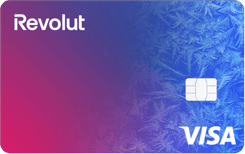
Revolut features
Revolut travel card pros and cons.
- Pick the Revolut account plan that suits your spending needs
- Hold and exchange 25+ currencies, and spend in 150 countries
- Accounts come with different card types, depending on which you select
- All accounts have some no fee currency exchange and some no fee ATM withdrawals monthly
- Some account tiers have travel perks like complimentary or discounted lounge access
- You need to upgrade to an account with a monthly fee to get all account features
- Delivery fees may apply for your travel card
- Fair usage limits apply once you exhaust your currency conversion and ATM no fee allowances
- Out of hours currency conversion has additional fees
How to apply for a Revolut card
Set up your Revolut account before you leave the US and order your travel card. Here’s how:
Download and open the Revolut app
Register by adding your personal and contact information
Follow the prompts to confirm your address and order your card
Pay any required delivery fee - costs depend on your account type
Chime travel card
Use your Chime account and card to spend in Amsterdam with no foreign transaction fee. You’ll just need to load a balance in USD and then the money is converted to EUR instantly with the Visa rate whenever you spend or make a withdrawal. There’s a fee to make an ATM withdrawal out of network, which sits at 2.5 USD, but there are very few other costs to worry about. Plus you can get lots of extra services from Chime if you need them, such as ways to save.
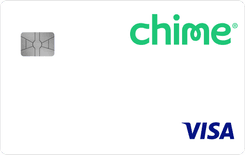
Chime features
Chime travel card pros and cons.
- No Chime foreign transaction fees
- No ongoing charges for your account
- Lots of extra products and services if you need them
- Easy ways to manage your money online and in app
- Virtual cards available
- You'll need to inform Chime you're traveling to use your card abroad
- Low ATM limits
- Cards take 7 - 10 days to arrive by mail
How to apply for a Chime card
Here’s how to apply for a Chime account and order a travel card in the US:
Visit the Chime website or download the app
Click Get started and add your personal details
Add a balance
Your card will be delivered in the mail and you can use your virtual card instantly
Monzo travel card
Monzo cards can be ordered easily in the US and used for spending in Amsterdam and globally. Monzo accounts are designed for holding USD only - but you can spend in EUR and pretty much any other currency easily, with no foreign transaction fee. Your funds are just converted using the network exchange rate whenever you pay or make a withdrawal.
Monzo doesn’t usually apply ATM fees, but it’s worth knowing that the operator of the specific ATM you pick may have their own costs you’ll need to check out.
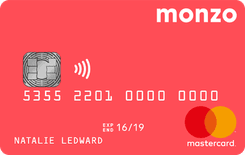
Monzo features
Monzo travel card pros and cons.
- Good selection of services available
- No foreign transaction fee to pay
- No Monzo ATM fee to pay
- Manage your card from your phone conveniently
- Deposits are FDIC protected
- You can't hold a foreign currency balance
- ATM operators might apply their own fees
How to apply for a Monzo card
Here’s how to apply for a Monzo account and order a travel card in the US:
Visit the Monzo website or download the app
Click Get Sign up and add your personal details
Check and confirm your mailing address and your card will be delivered in the mail
Netspend travel card
Netspend has a selection of prepaid debit cards you can use for spending securely in Amsterdam. While these cards don’t usually let you hold a balance in EUR, they’re popular with travelers as they’re not linked to your regular checking account. That increases security overseas - plus, Netspend offers virtual cards you can use to hide your physical card details from retailers if you want to.
The options with Netspend vary a lot depending on the card you pick. Usually you can top up digitally or in cash in USD and then spend overseas with a fixed foreign transaction fee applying every time you spend in a foreign currency. You’ll be able to view the terms and conditions of your specific card - including the fees - online, by entering the code you’ll find when your card is sent to you.

Netspend features
Netspend travel card pros and cons.
- Large selection of different card options depending on your needs
- Some cards have no overseas ATM fees
- Prepaid card which is secure to use overseas
- Manage your account in app
- Change from one card plan to another if you need to
- You may pay a monthly fee for your card
- Some cards have foreign transaction fees for all overseas use, which can be around 4%
- Selection of fees apply depending on the card you pick
How to apply for a Netspend card
Here’s how to apply for a Netspend account and order a travel card in the US:
Visit the Netspend website
Click Apply now
Complete the details, following the onscreen prompts
Get verified
Your card will arrive by mail - add a balance and activate it to get started
PayPal travel card
PayPal has a debit card you can link to your PayPal balance account, to spend in Amsterdam as well as locally, in person and online. One advantage of PayPal is that there are lots of easy ways to add money in USD - but bear in mind that when you spend in EUR you’ll likely pay a foreign transaction fee of 2.5%. ATM fees apply when you make out of network withdrawals, too, which can push up the costs depending on how you use your card.
PayPal travel cards aren’t connected to your checking account which makes them a handy and secure way to spend, particularly if you already have a PayPal balance account.
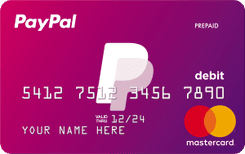
PayPal features
Paypal travel card pros and cons.
- Globally accepted card
- Easy ways to top up your PayPal balance including cash and check
- Popular and reliable provider
- Use your card for spending online easily as well
- 2.5 USD fee for out of network ATM withdrawals
- 2.5% fee when you spend in a foreign currency
- Other charges may apply depending on how you fund and use your account
How to apply for a PayPal card
Here’s how to apply for a PayPal account and order a travel card in the US:
Visit the PayPal website or download the app
Click Get Sign up or log into your existing account
Add your personal details to create an account, or tap Request a card if you already have a PayPal account
Follow the prompts to order your card
What is a travel money card?
A travel money card is a card you can use for secure and convenient payments and withdrawals overseas.
You can use a travel money card to tap and pay in stores and restaurants, with a wallet like Apple Pay, or to make ATM withdrawals so you'll always have a bit of cash in your pocket when you travel.
Although there are lots of different travel money cards on the market, all of which are unique, one similarity you'll spot is that the features and fees have always been optimised for international use. That might mean you get a better exchange rate compared to using your normal card overseas, or that you run into fewer fees for common international transactions like ATM withdrawals.
Travel money cards also offer distinct benefits when it comes to security. Your travel money card isn't linked to your United States Dollar everyday account, so even if you were unlucky and had your card stolen, your primary bank account remains secure.
Travel money vs prepaid card vs travel credit card
It's helpful to know that you'll be able to pick from several different types of travel cards, depending on your priorities and preferences. Travel cards commonly include:
- Travel debit cards
- Travel prepaid cards
- Travel credit cards
They all have distinct benefits when you head off to Amsterdam or elsewhere in the world, but they do work a bit differently.
Travel debit and prepaid cards are usually linked to an online account, and may come from specialist digital providers - like the Wise card. These cards are usually flexible and cheap to use. You'll be able to manage your account and card through an app or on the web.
Travel credit cards are different and may suit different customer needs. As with any other credit card, you may need to pay an annual fee or interest and penalties depending on how you manage your account - but you could also earn extra rewards when spending in a foreign currency, or travel benefits like free insurance for example. Generally using a travel credit card can be more expensive compared to a debit or prepaid card - but it does let you spread out the costs of your travel across several months if you'd like to and don't mind paying interest to do so.
What is a prepaid travel money card best for?
Let's take a look at the advantages of using a prepaid travel money card for travellers going to Amsterdam. While each travel card is a little different, you'll usually find some or all of the following benefits:
- Hold and exchange foreign currencies - allowing you to lock in exchange rates and set a travel budget before you leave
- Convenient for spending in person and through mobile wallets like Apple Pay, as well as for cash withdrawals
- You may find you get a better exchange rate compared to your bank - and you'll usually be able to avoid any foreign transaction fee, too
- Travel cards are secure as they're not linked to your everyday USD account - and because you can make ATM withdrawals when you need to, you can also avoid carrying too much cash at once
Overall, travel cards offer flexible and low cost ways to avoid bank foreign transaction and international ATM fees, while accessing decent exchange rates.
How to choose the best travel card for Amsterdam
We've picked out 6 great travel cards available in the US - but there are also more options available, which can make choosing a daunting task. Some things to consider when picking a travel card for Amsterdam include:
- What exchange rates does the card use? Choosing one with the mid-market rate or as close as possible to it is usually a smart plan
- What fees are unavoidable? For example, ATM charges or top up fees for your preferred top up methods
- Does the card support a good range of currencies? Getting a card which allows you to hold and spend in EUR can give you the most flexibility, but it's also a good idea to pick a card with lots of currency options, so you can use it again in future, too
- Are there any other charges? Check in particular for foreign transaction fees, local ATM withdrawal fees, inactivity fees and account close fees
Ultimately the right card for you will depend on your specific needs and preferences.
What makes a good travel card for Amsterdam
The best travel debit card for Amsterdam really depends on your personal preferences and how you like to manage your money.
Overall, it pays to look for a card which lets you minimise fees and access favourable exchange rates - ideally the mid-market rate. While currency exchange rates do change all the time, the mid-market rate is a good benchmark to use as it’s the one available to banks when trading on wholesale markets. Getting this rate, with transparent conversion fees, makes it easier to compare costs and see exactly what you’re paying when you spend in EUR.
Other features and benefits to look out for include low ATM withdrawal fees, complimentary travel insurance, airport lounge access or emergency cash if your card is stolen. It’s also important to look into the security features of any travel card you might pick for Amsterdam. Look for a card which uses 2 factor authentication when accessing the account app, which allows you to set instant transaction notifications, and which has easy ways to freeze, unfreeze and cancel your card with your phone.
For Amsterdam in particular, choosing a card which offers contactless payments and which is compatible with mobile wallets like Apple Pay could be a good plan. Card payments are extremely popular in Amsterdam - so having a card which lets you tap and pay easily can speed things up and make it more convenient during your trip.
Ways to pay in Amsterdam
Cash and card payments - including contactless, mobile wallet, debit, credit and prepaid card payments - are the most popular ways to pay globally.
In Amsterdam card payments are common in most situations. You’ll be able to make Chip and PIN or contactless payments or use your favourite mobile wallet like Apple Pay to tap and pay on the go. It’s still worth having a little cash on you just in case - and for the odd situations where cash is more convenient, such as when tipping or buying a small item in a market.
Which countries use EUR?
If you have EUR, you should be able to use it in a few countries. You may decide to keep your travel card topped up with a balance for this trip to Amsterdam or for the next time you’re headed somewhere which uses EUR.
What should you be aware of when travelling to Amsterdam
You’re sure to have a great time in Amsterdam - but whenever you’re travelling abroad it's worth putting in a little advance thought to make sure everything is organised and your trip goes smoothly. Here are a few things to think about:
1. Double check the latest entry requirements and visas - rules can change abruptly, so even if you’re been to Amsterdam before it’s worth looking up the most recent entry requirements so you don’t have any hassle on the border
2. Plan your currency exchange and payment methods - you can change USD to EUR before you travel to Amsterdam if you’d like to, but as card payments are common, and ATMs widely available, you can actually leave it until you arrive to get everything sorted as long as you have a travel money card. Top up your travel money card in USD and either exchange to EUR in advance or at the point of payment, and make ATM withdrawals whenever you need cash. Bear in mind that currency exchange at the airport will be expensive - so hold on until you reach Amsterdam to make an ATM withdrawal in EUR if you can.
3. Get clued up on any health or safety concerns - get travel insurance before you leave the US so you have peace of mind. It’s also worth reading up on any common scams or issues experienced by tourists. These tend to change over time, but may include things like rip off taxis or tour agents which don’t offer fair prices or adequate services.
Conclusion - Best travel cards for Amsterdam
Ultimately the best travel card for your trip to Amsterdam will depend on how you like to manage your money. Use this guide to get some insights into the most popular options out there, and to decide which may suit your specific needs.
FAQ - best travel cards for Amsterdam
When you use a travel money card you may find there’s an ATM withdrawal fee from your card issuer, and there may also be a cost applied by the ATM operator. Some of our travel cards - like the Wise and Revolut card options - have some no fee ATM withdrawals every month, which can help keep down costs.
Travel money cards may be debit, prepaid or credit cards. Which is best for you will depend on your personal preferences. Debit and prepaid cards are usually pretty cheap and secure to spend with, while credit cards may have higher fees but often come with extra perks like free travel insurance and extra reward points.
There’s no single best prepaid card for international use. Look out for one which supports a large range of currencies, with good exchange rates and low fees. This guide can help you compare some popular options, including Wise, Revolut and Monzo.
Yes, you can use your local debit card when you’re overseas. However, it’s common to find extra fees apply when spending in foreign currencies with a regular debit card. These can include foreign transaction fees and international ATM charges.
Usually having a selection of ways to pay - including a travel card, your credit or debit card, and some cash - is the best bet. That means that no matter what happens, you have an alternative payment method you can use conveniently.
Yes. Most travel debit cards have options to make ATM withdrawals. Check the fees that apply as card charges do vary a lot. Some cards have local and international fees on all withdrawals, while others like Wise and Revolut, let you make some no fee withdrawals monthly before a fee kicks in.
Both Visa and Mastercard are globally accepted. Look out for the logo on ATMs and payment terminals in Amsterdam.
The cards you see on this page are ordered as follows:
For card providers that publish their exchange rates on their website, we used their USD / EUR rate to calculate how much Euro you would receive when exchanging / spending $4,000 USD. The card provider offering the most EUR is displayed at the top, the next highest below that, and so on.
The rates were collected at 15:54:21 GMT on 19 February 2024.
Below this we display card providers for which we could not verify their exchange rates. These are displayed in alphabetical order.
Send international money transfer
More travel card guides.

IMAGES
VIDEO
COMMENTS
5 travel tips for saving money in Amsterdam. Rent or Airbnb an apartment. One of the most popular ways to sleep well and affordably nowadays is by renting an apartment short-term. Apartment rentals may be cheaper per person per night than your average hotel or hostel. Buy an I Amsterdam Card.
Amsterdam, like much of the Netherlands, primarily uses the Euro (€) as its official currency. Introduced in 2002, the Euro has since become a significant part of European trade and economics. In 2024, tourists and residents in Amsterdam will encounter Euro banknotes and coins in various denominations. Banknotes come in 5, 10, 20, 50, 100 ...
Station Amsterdam Sloterdijk. Name: GWK Travelex. Address: Orlyplein 107. Opening hours: Monday to Friday - 10:00 - 17:00. Saturday and Sunday: closed. There are also money exchange offices in areas with shops, such as Leidsestraat and Kalverstraat. Find the best money exchange location near you via Google Maps.
Amsterdam Travel Guide: Money-Saving Tips. Amsterdam is one of the most popular tourist destinations in Europe — and one of the most expensive. Every year prices go up, especially now, post-COVID. Fortunately, a visit here doesn't have to break the bank because there are a lot of ways to save money in Amsterdam:
Updated: April 18, 2024. Knowing what currency is used in the Netherlands is critical if you're heading to the land of windmills and tulips. Money makes the world go round, so allow us to enlighten you on what you'll need to pay in Amsterdam and beyond. The euro, used in many European countries, is the currency the Netherlands uses today.
The European euro (€) is the currency in the Netherlands. There are 100 euro cents to each euro. The euro coins are: .01€, .02€, .05€, .10€, .20€, .50€ (1, 2, 5, 10, 20, and 50 euro cents), 1€, and 2€. The euro notes are 5€, 10€, 20€, 50€, 100€, 200€, and 500€. Holland does not produce its own 1 and 2 euro cent ...
More Amsterdam Tips. Explore the Diamond Markets. This might sound like strange advice for budget travelers, but it is actually a penny-pinching tip. Amsterdam is home to some of the world's best diamond cutters, many of whom will give free, fascinating demonstrations. Looking at their finished creations is free, too.
In Amsterdam, there are a few ways to save on public transport: As I mentioned in my post, 35 mistakes first-time visitors make: Do not buy one-way tickets from the driver. Just tap your contactless debit or credit card when you enter (like the locals do) and when you exit. That by itself saves you 30-70%.
Don't expect to rely on U.S. dollars in Amsterdam: as a member of the eurozone, the Netherlands is one of 19 countries in the European Union that's adopted the euro as its official currency.The value of the euro has fluctuated considerably since it was first introduced in 2002 - from parity with the dollar in 2002, to $1.60 2008, and back to near-parity in 2015.
Different Ways to Exchange Currency in Amsterdam and Beyond. 🚨 Option 1: Use Your Credit Card From Home. 🚨 Option 2: Exchange Your Currency And Buy Euro Before You Leave. 🚨 Option 3: Exchange Euro at the Airport. 🚨 Option 4: Withdraw Cash From an ATM After Arrival. Option 5: Use a Wise Borderless Debit Card.
Take a travel money card to Amsterdam and avoid transaction fees completely. All travel cards will allow you to load and spend euros in the Netherlands. You won't incur the additional currency conversion fee of between 2.5% and 3% which applies to the majority of personal finance products. If you are considering taking a travel card to access ...
In addition to exchanging your euros, you can visit our currency exchange offices in Amsterdam to sell back your excess foreign money after a trip. You can also exchange and buy foreign currency online via our website. Order your foreign currency online now and take advantage of the best GWK Travelex exchange rates and 0% commission!
What Currency is Used in Amsterdam. As stated above, the official currency of Amsterdam and the rest of the Netherlands is the euro, which is the currency for almost all of the European Union (EU) nations. Euro Banknotes and Coins. Euro banknotes come in these denominations: €5, €10, €20, €50, €100, €200, and €500.
Amsterdam's burgeoning food scene has something to cater to every type of diner, and every travel budget. If you have any appetite left after all the tasty market treats, try these stylish budget restaurants that definitely do not skimp on flavour. It's also well worth saving up for one celebratory blowout meal at one of the city's top-rated restaurants where innovative chefs are putting ...
Here are 10 ways to make that happen: 1. Avoid taxis if you can. Amsterdam is small and walkable, and public transport covers all areas of the city. A cab ride that costs you €20 to Museum Square is a quick and cheap €2.80 on the tram. Please note: The city is not car-friendly, so time is rarely saved when cabbing it.
1. GWK Travelex @ Damrak. - This branch is located beside KFC, just a short walk from the National Monument and the Royal Palace. - Address: Damrak 86, 1012 LP Amsterdam, Netherlands. - Phone: +31 20 624 6682. - Opening hours: Monday to Saturday 09:00 - 20:00; Sunday 11:00 - 18:00.
Still, if you don't want to use your feet everywhere, public transportation is affordable. Prices start from €3.20 ($3.75) for a single, 1-hour ticket. The day passes currently cost €8.00 ($9.40). It's safe to drink the tap water in Amsterdam. If you don't want to pay every time you get thirsty, we have some good news!
6 best travel money cards for Amsterdam: Let's kick off our roundup of the best travel cards for Amsterdam with a head to head comparison on important features. Here's an overview of the providers we've picked to look at, for customers looking for ways to spend conveniently overseas when travelling from the US: